Why you can trust Tom's Hardware
Corsair MP600 Mini (E27T) Comparison Products
We're only comparing M.2 2230 drives with other SSDs using the same form factor. For this review, we have the older Inland TN436, the newer Inland TN446, and the QLC-based Inland QN446. If we’re looking at TLC flash at 2TB, currently there’s the WD SN740 and Black SN770M. Corsair’s original MP600 Mini may be phased out and there’s no word on the future of the QLC-based MP600 Core Mini. Another direct rival comes from Sabrent, currently with its Rocket 2230 and Rocket Q4 2230. We expect an M.2 2242 drive from the company in the near future, as well as a 2230 drive similar to the updated MP600 Mini.
Rounding out drives from other players, we have the Lexar Play SSD, the only 2230 drives we've tested that uses an SMI controller. We round things out with several other 2TB models using QLC NAND and the E21T controller: the Silicon Power UD90 2230, Addlink S91, and Teamgroup MP44S. A few of our test results (ATTO and our write saturation Iometer results) omit the S91 and UD90, as we can only have 12 SSDs per chart, but the results are effectively identical to the other drives that have 2TB of QLC with the E21T controller.
Trace Testing — 3DMark Storage Benchmark
Built for gamers, 3DMark’s Storage Benchmark focuses on real-world gaming performance. Each round in this benchmark stresses storage based on gaming activities including loading games, saving progress, installing game files, and recording gameplay video streams. Future gaming benchmarks will be DirectStorage-inclusive and we include details of that where possible.
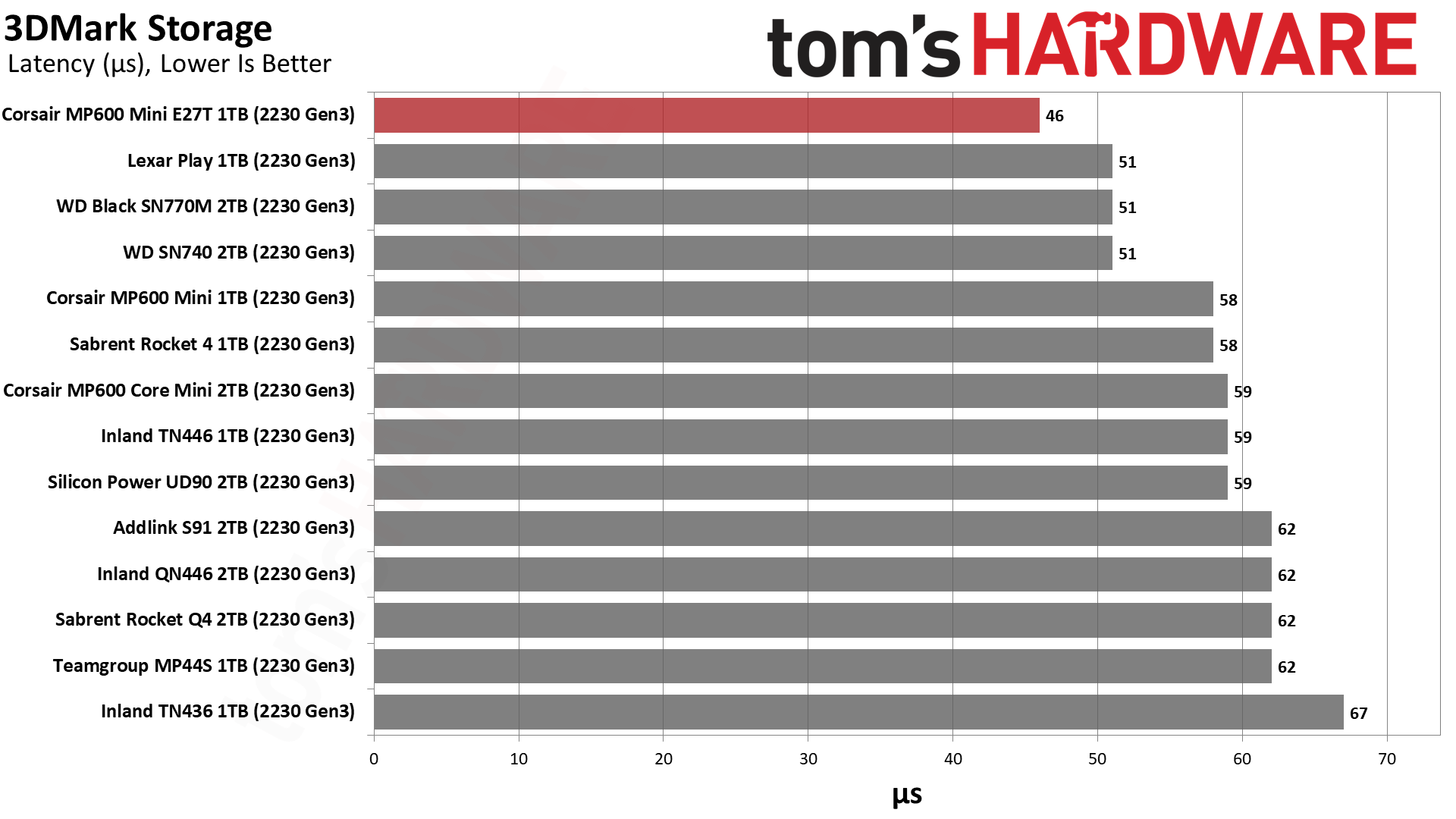
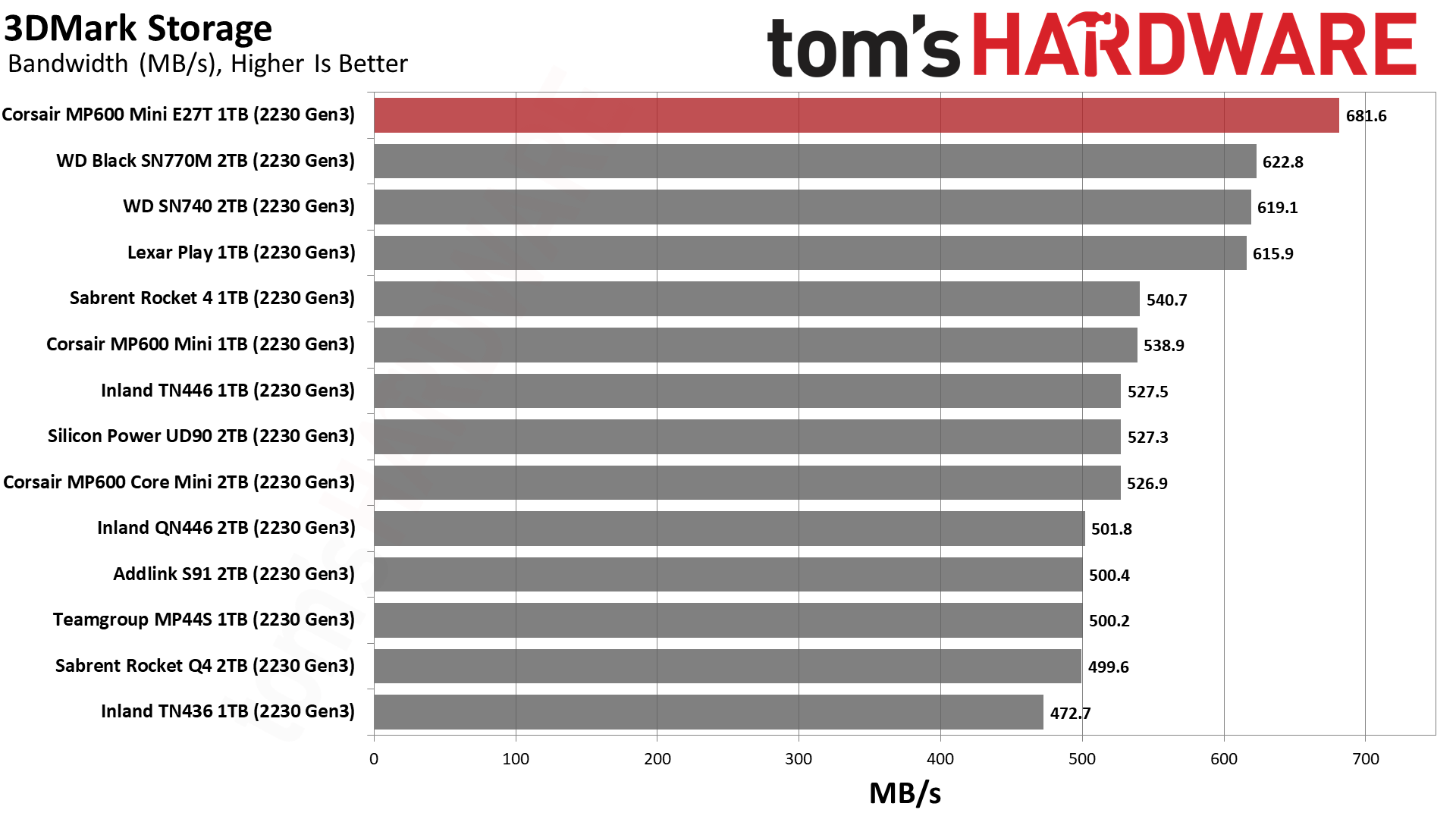
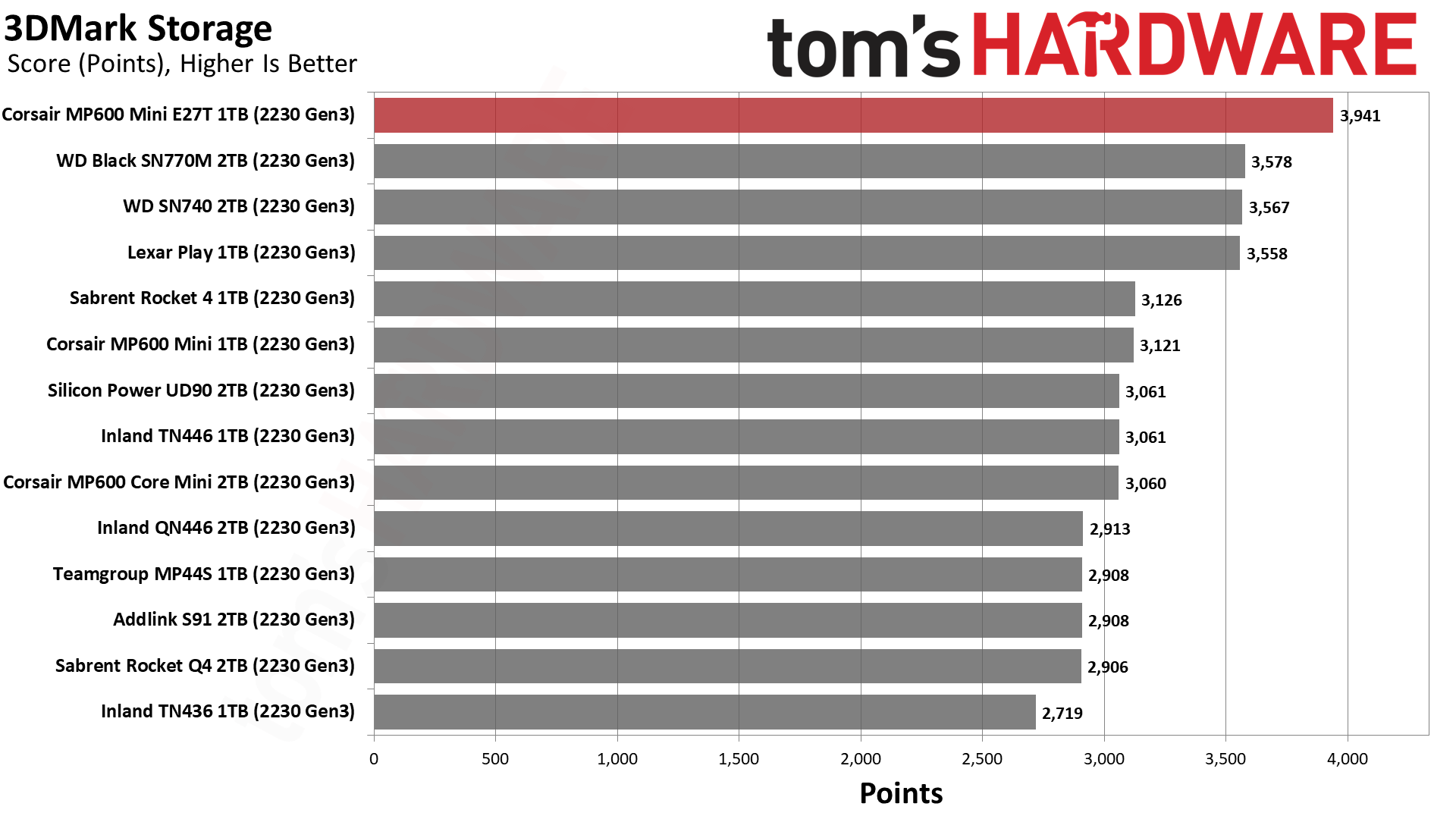
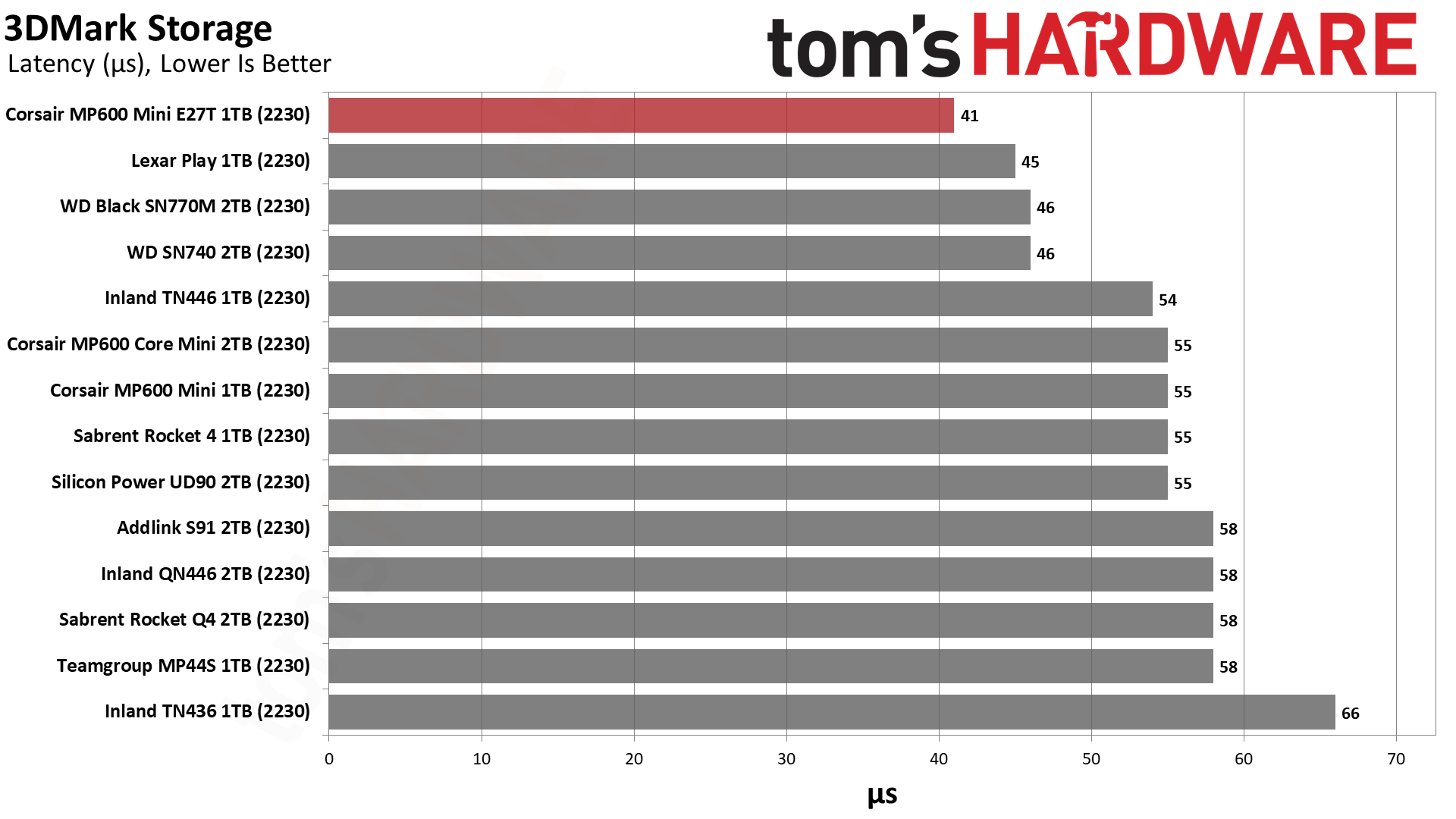
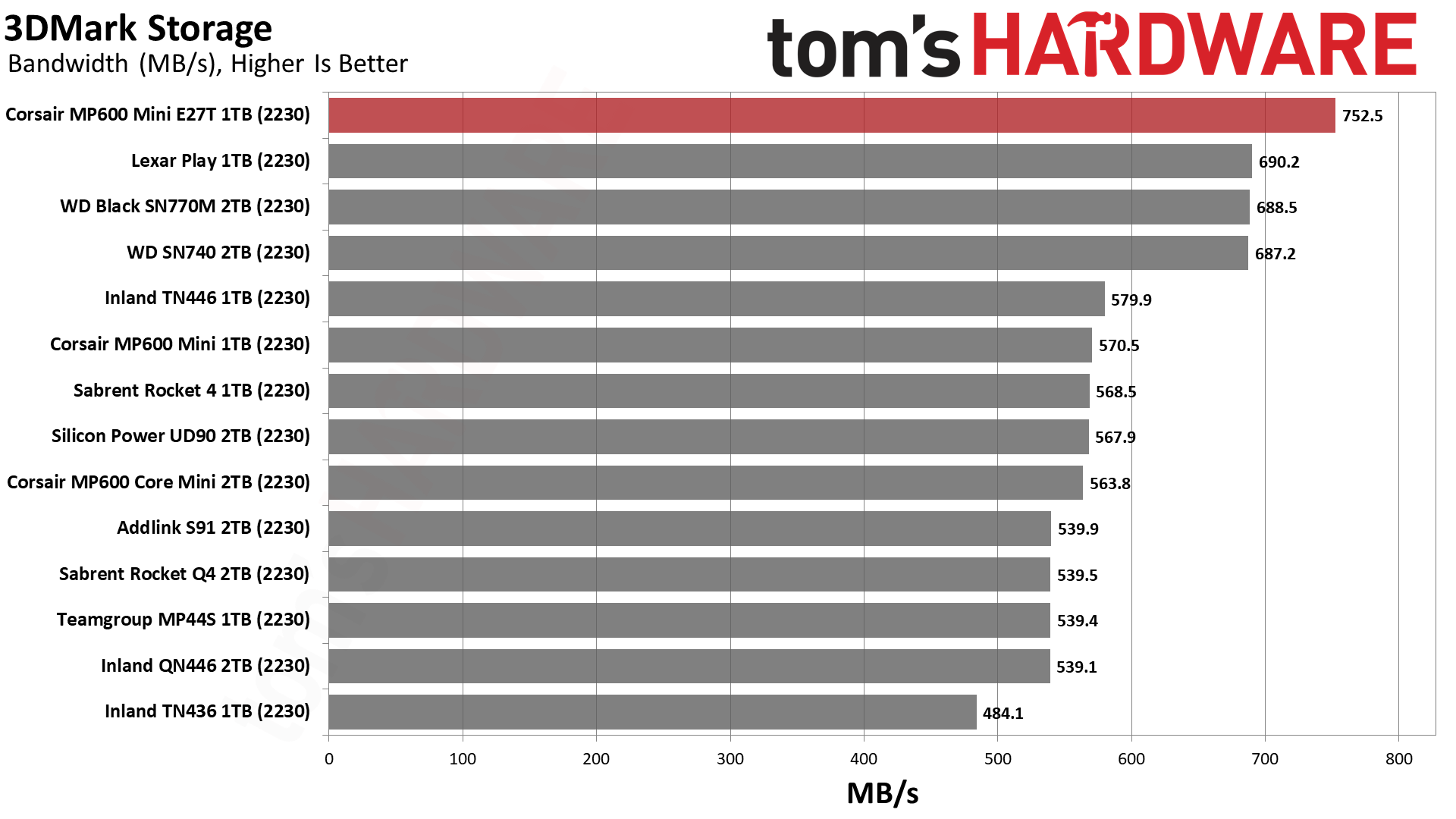
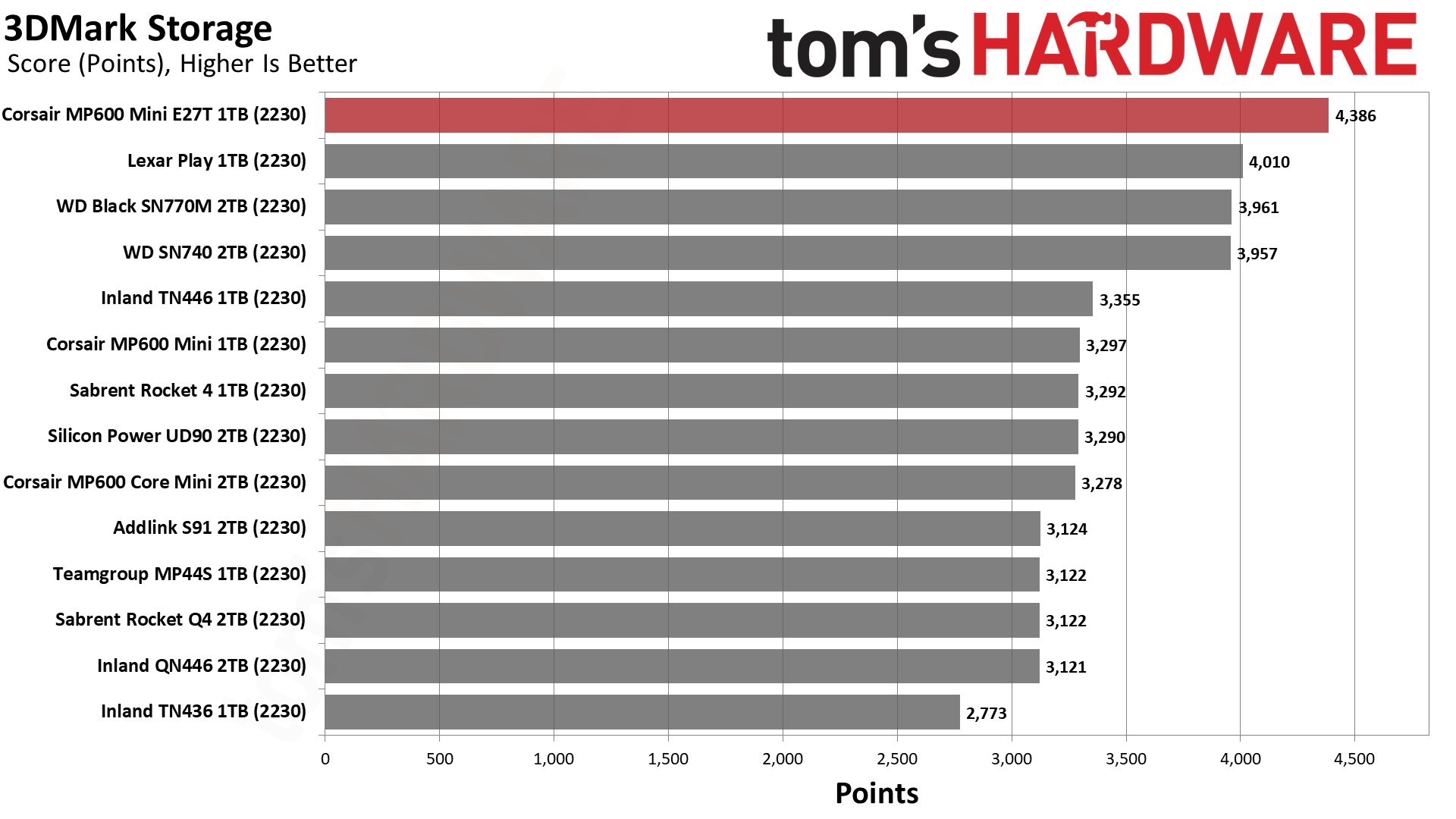
The MP600 Mini is delightfully fast in 3DMark, beating all other M.2 2230 drives in our testbed. It’s simply the fastest option to date. This goes for both PCIe 3.0 and 4.0 modes. The E27T optionally supports Phison’s I/O+ firmware that's optimized for DirectStorage, so we can assume game performance will be excellent regardless of platform or API.
Trace Testing — PCMark 10 Storage Benchmark
PCMark 10 is a trace-based benchmark that uses a wide-ranging set of real-world traces from popular applications and everyday tasks to measure the performance of storage devices.
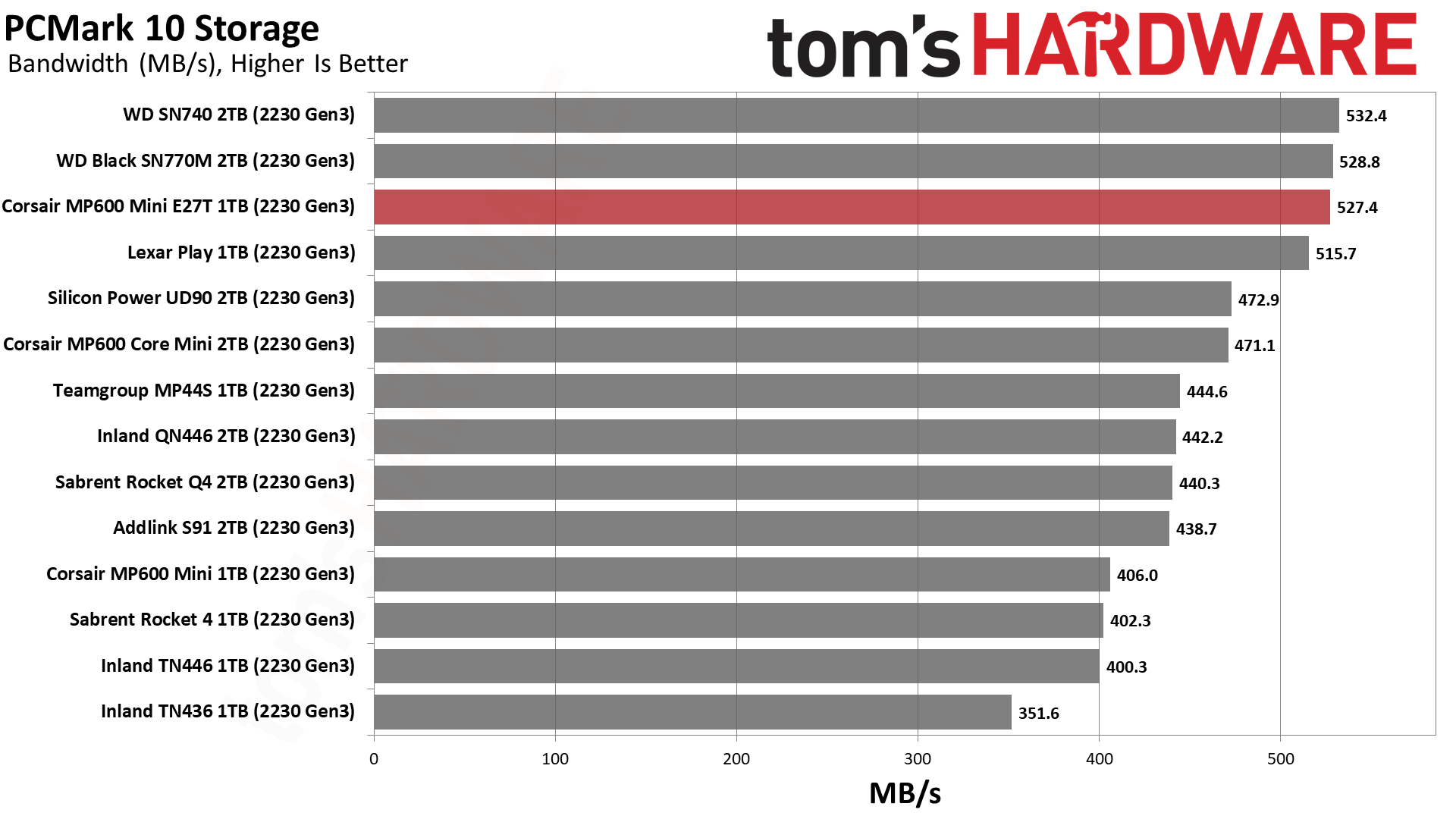
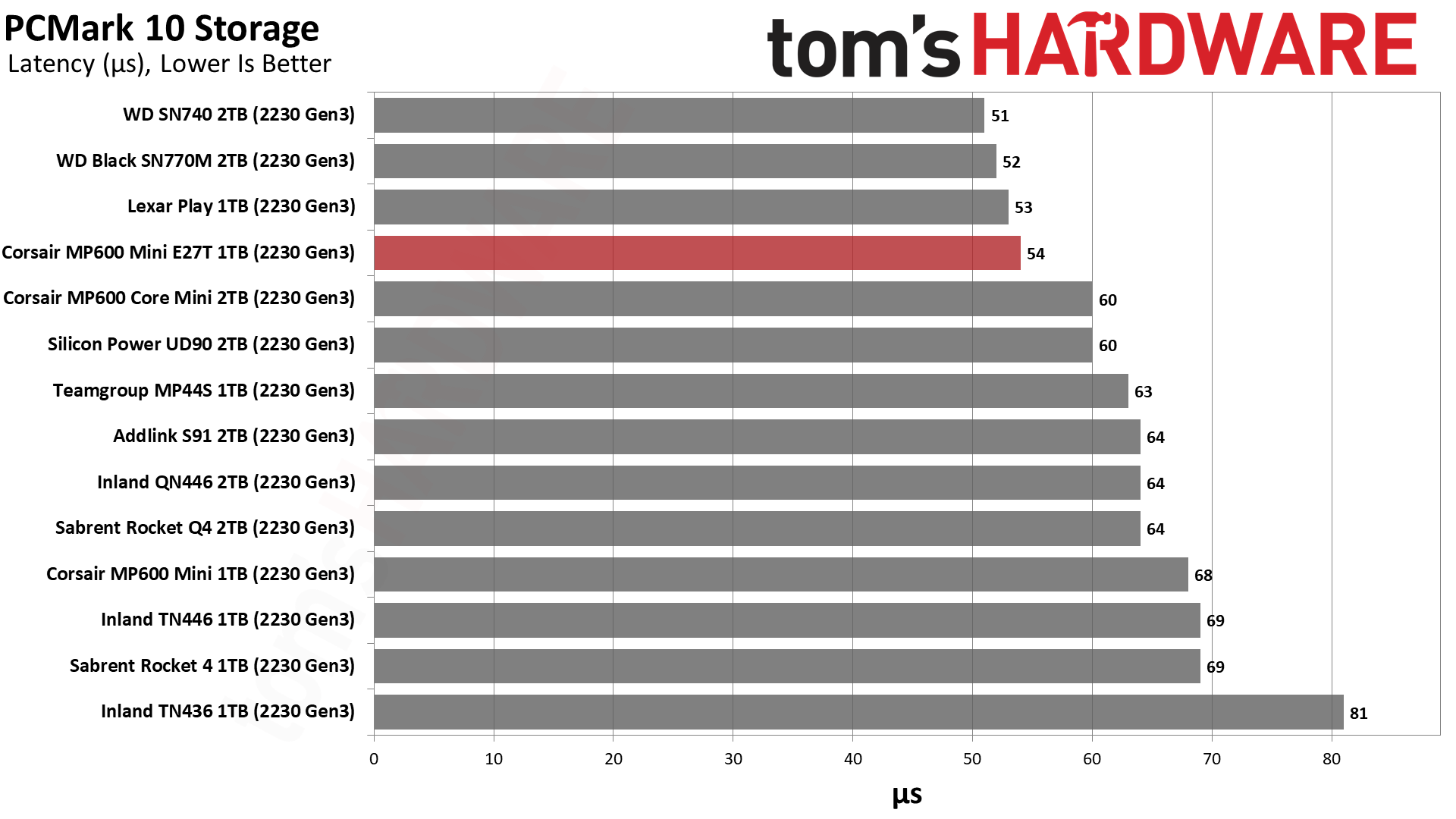

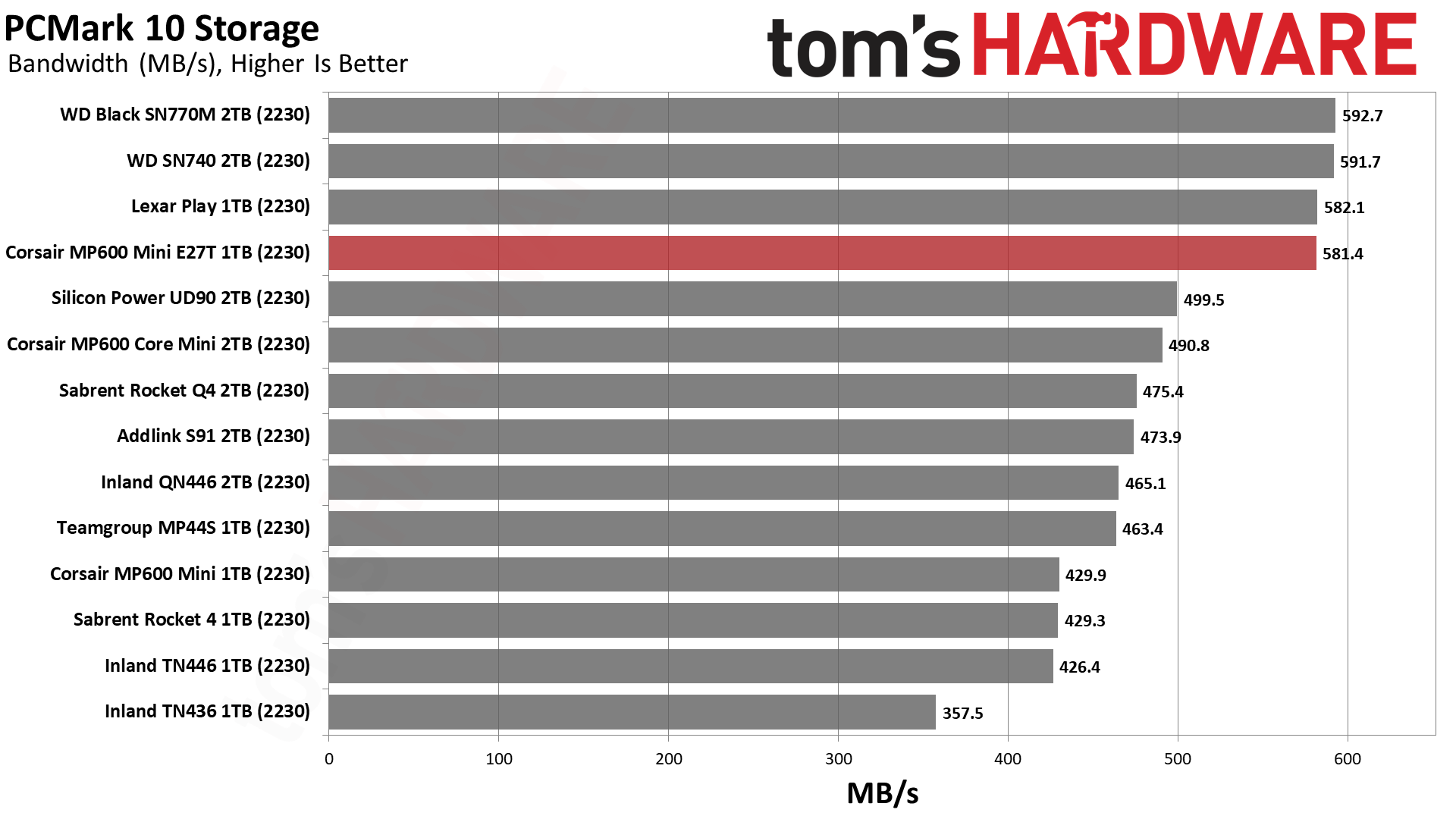

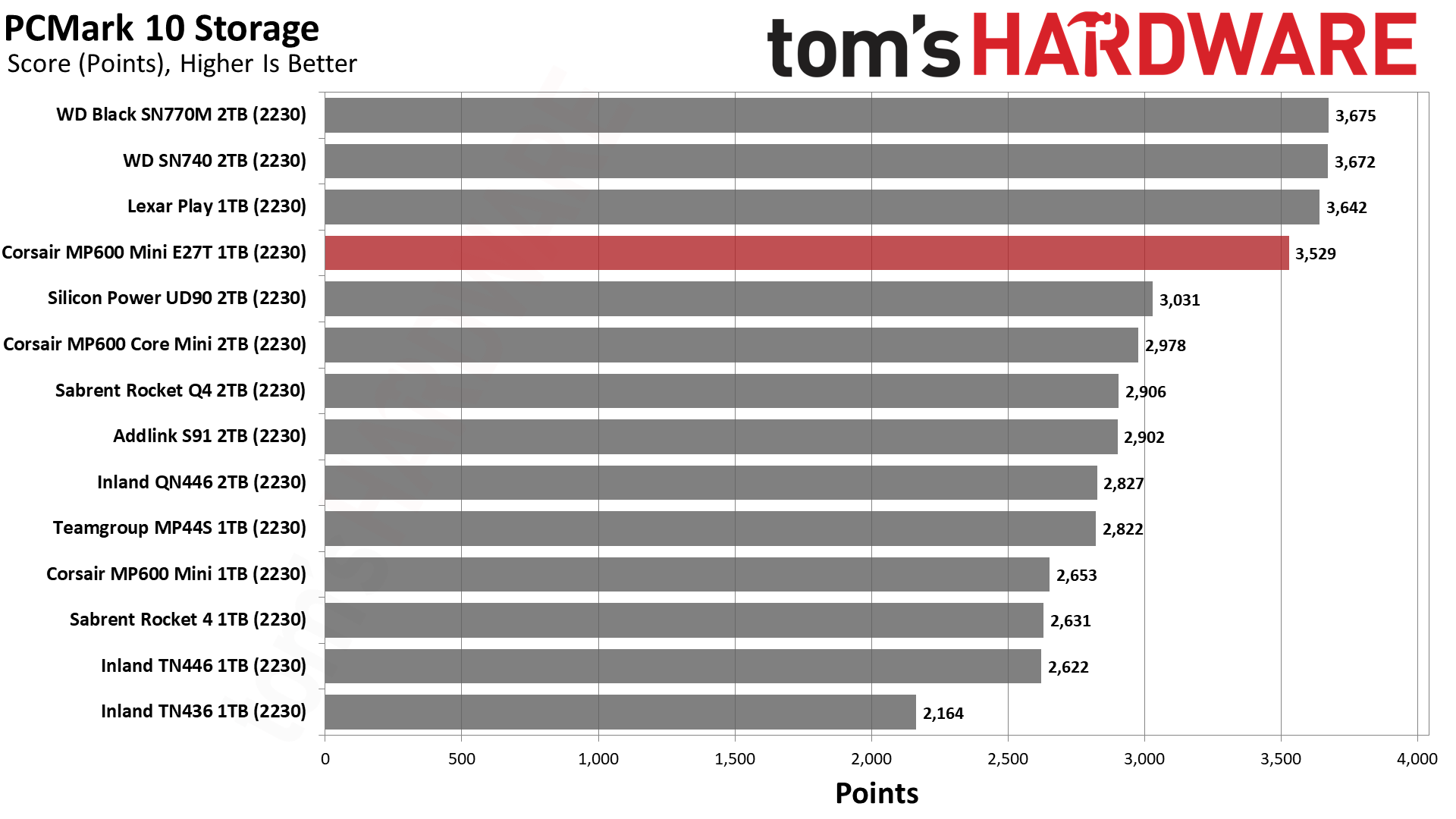
PCMark 10 performance is also good, although not as good as what we saw with 3DMark. WD’s drives, which use a proprietary controller with BiCS5, and the Lexar Play, which uses an SMI controller, are a little bit faster. The MP600 Mini is still faster than its original revision and all of its peers, regardless of whether they use TLC or QLC flash.
Transfer Rates — DiskBench
We use the DiskBench storage benchmarking tool to test file transfer performance with a custom, 50GB dataset. We write 31,227 files of various types, such as pictures, PDFs, and videos to the test drive, then make a copy of that data to a new folder, and follow up with a reading test of a newly-written 6.5GB zip file. This is a real world type workload that fits into the cache of most drives.

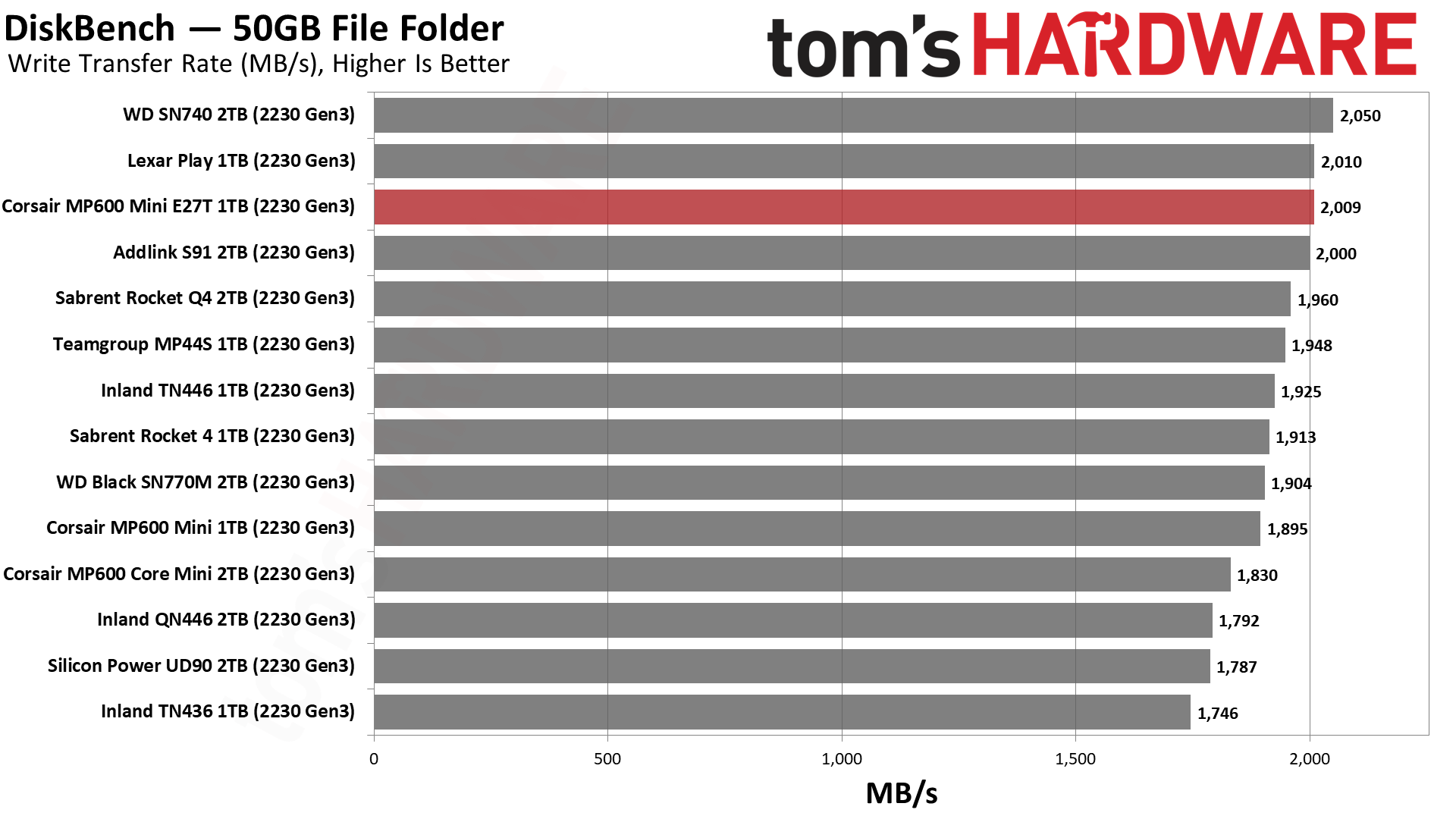
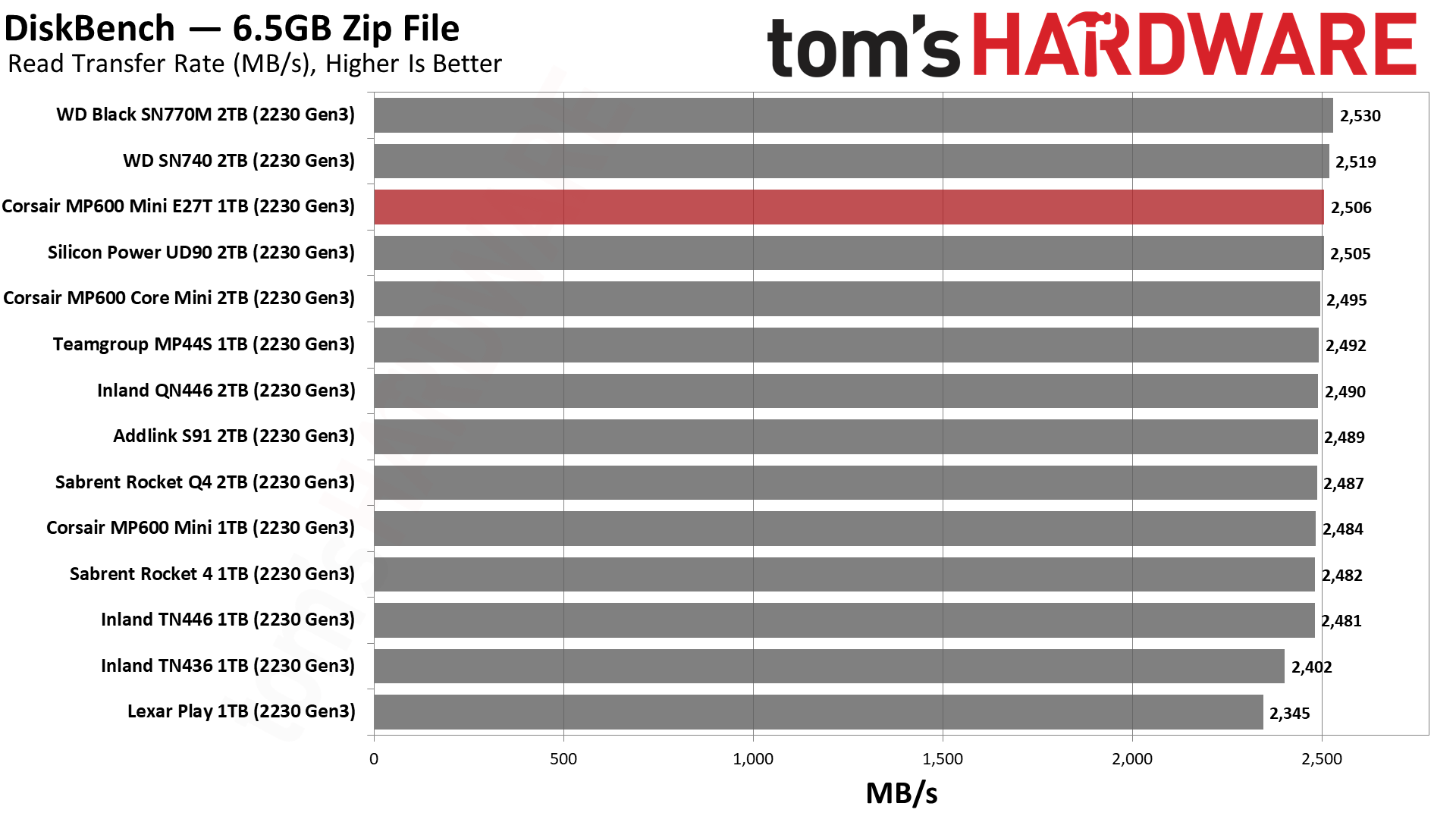
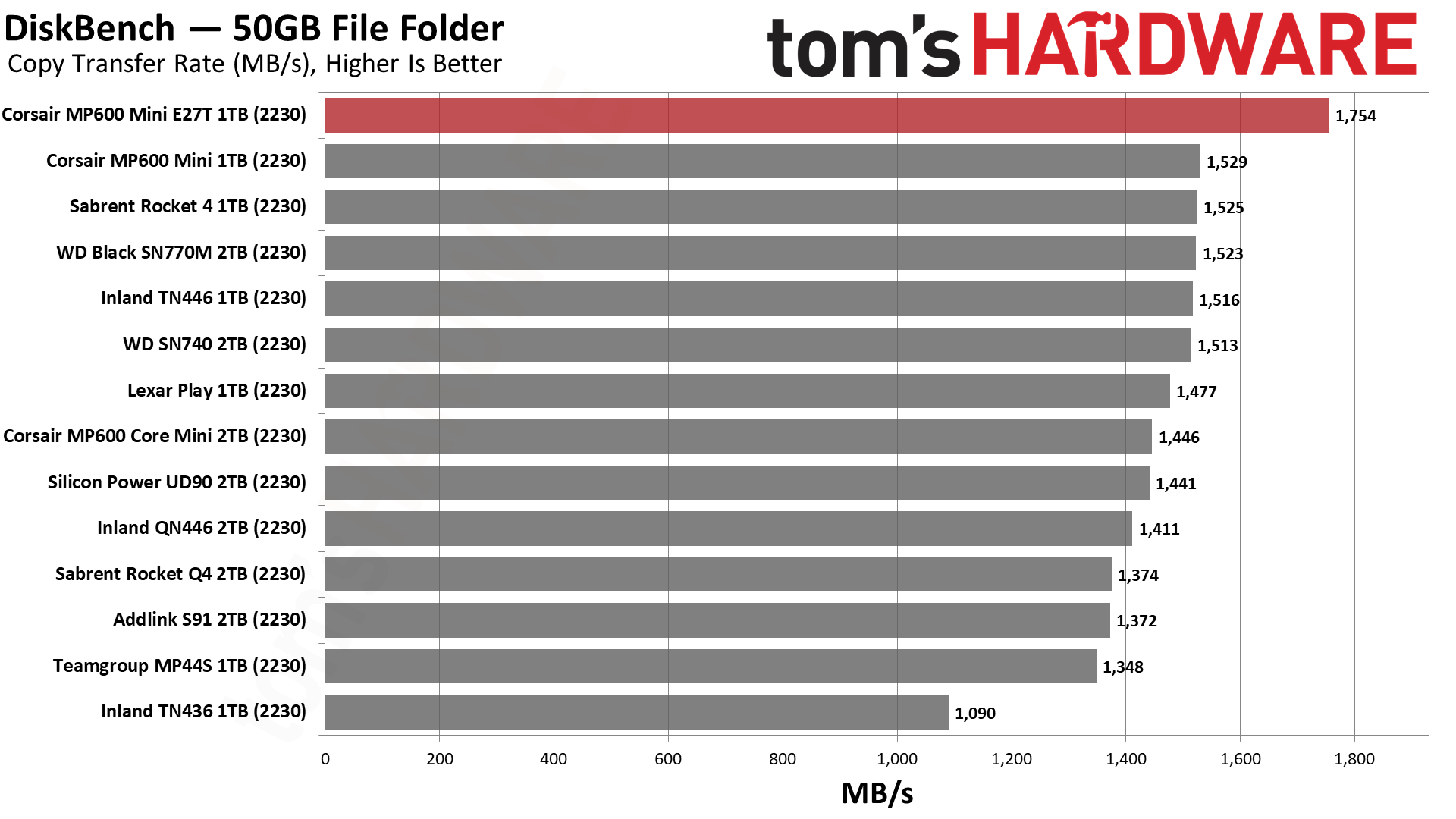
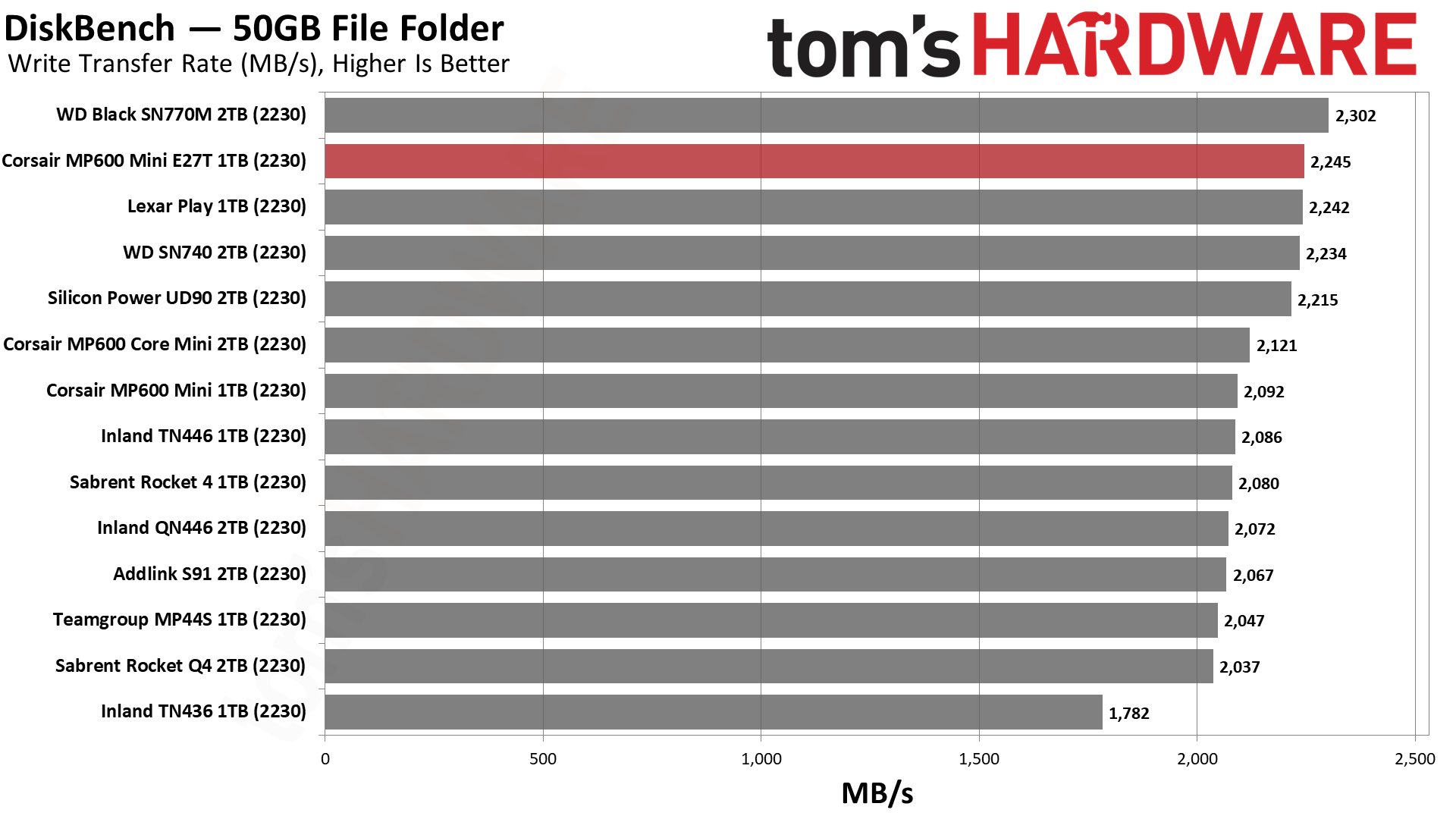
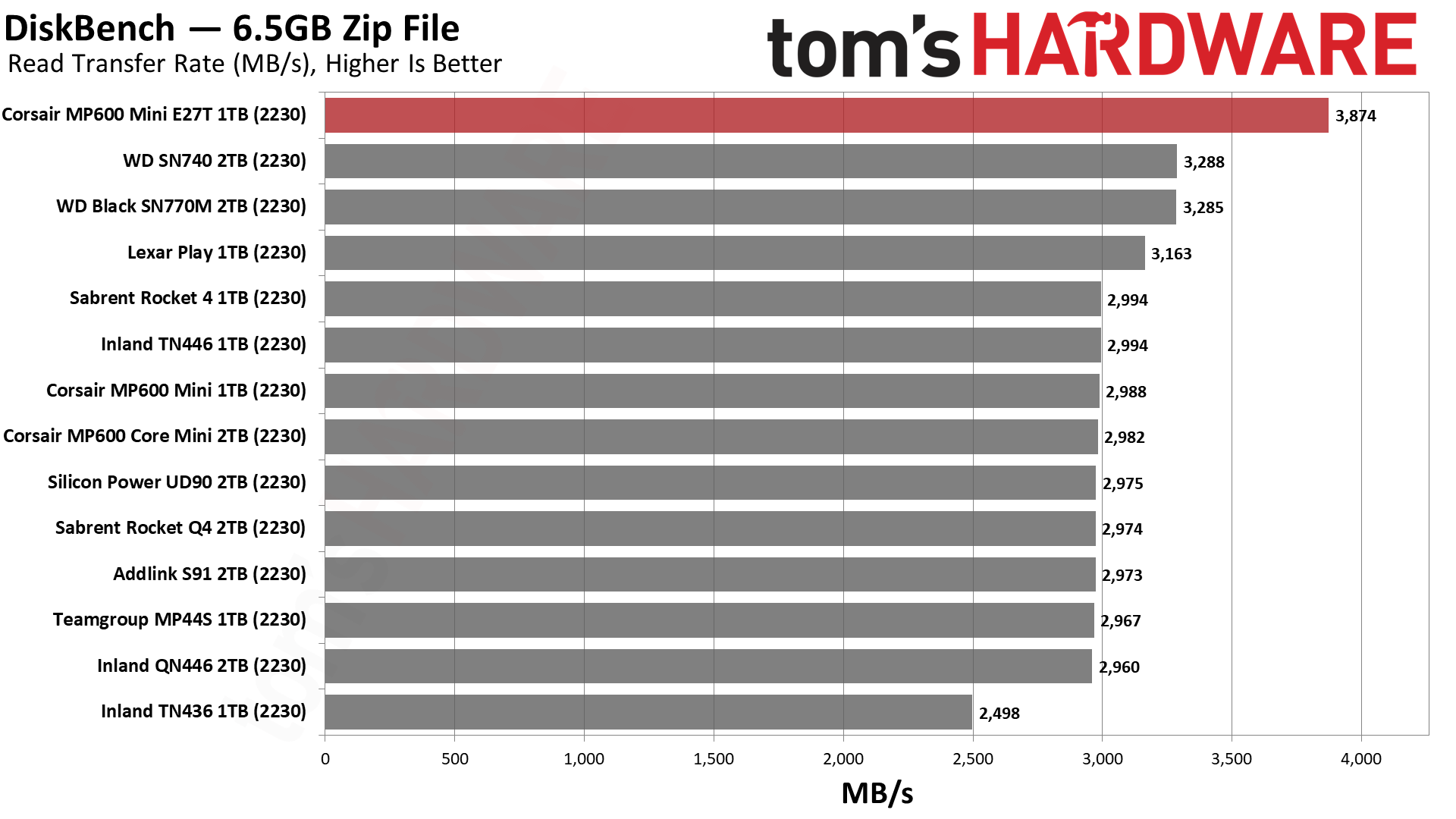
The BiCS6 TLC flash is surprisingly fast, delivering the fastest transfer speeds we’ve ever seen from an M.2 2230 SSD. This test fits within the MP600 Mini’s relatively small SLC cache so it can reach peak performance. We think transfer performance is good enough with older TLC-based drives and 2TB QLC-based drives, but the MP600 Mini gets things done a little bit faster.
Get Tom's Hardware's best news and in-depth reviews, straight to your inbox.
Synthetic Testing — ATTO / CrystalDiskMark
ATTO and CrystalDiskMark (CDM) are free and easy-to-use storage benchmarking tools that SSD vendors commonly use to assign performance specifications to their products. Both of these tools give us insight into how each device handles different file sizes and at different queue depths.
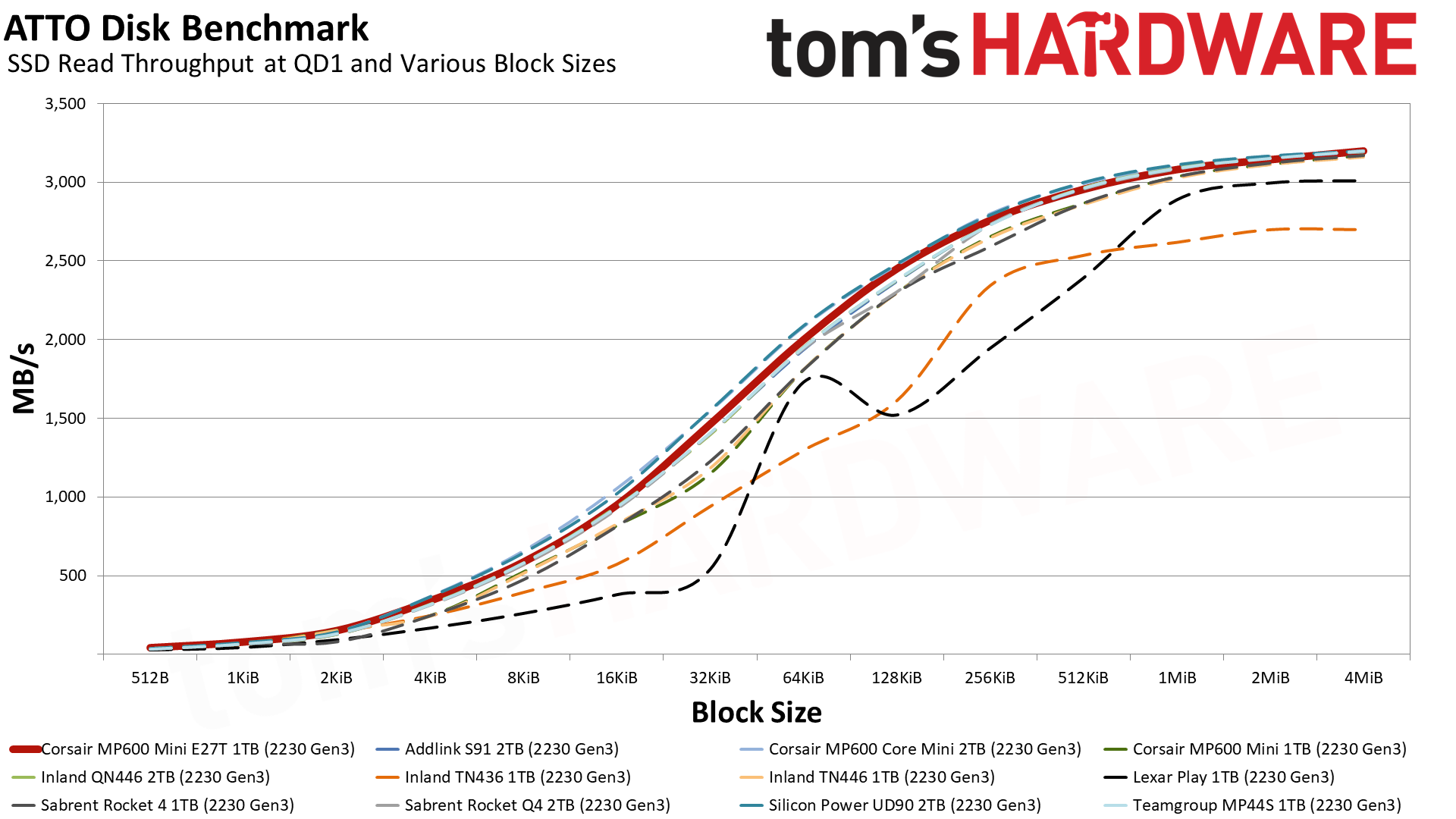
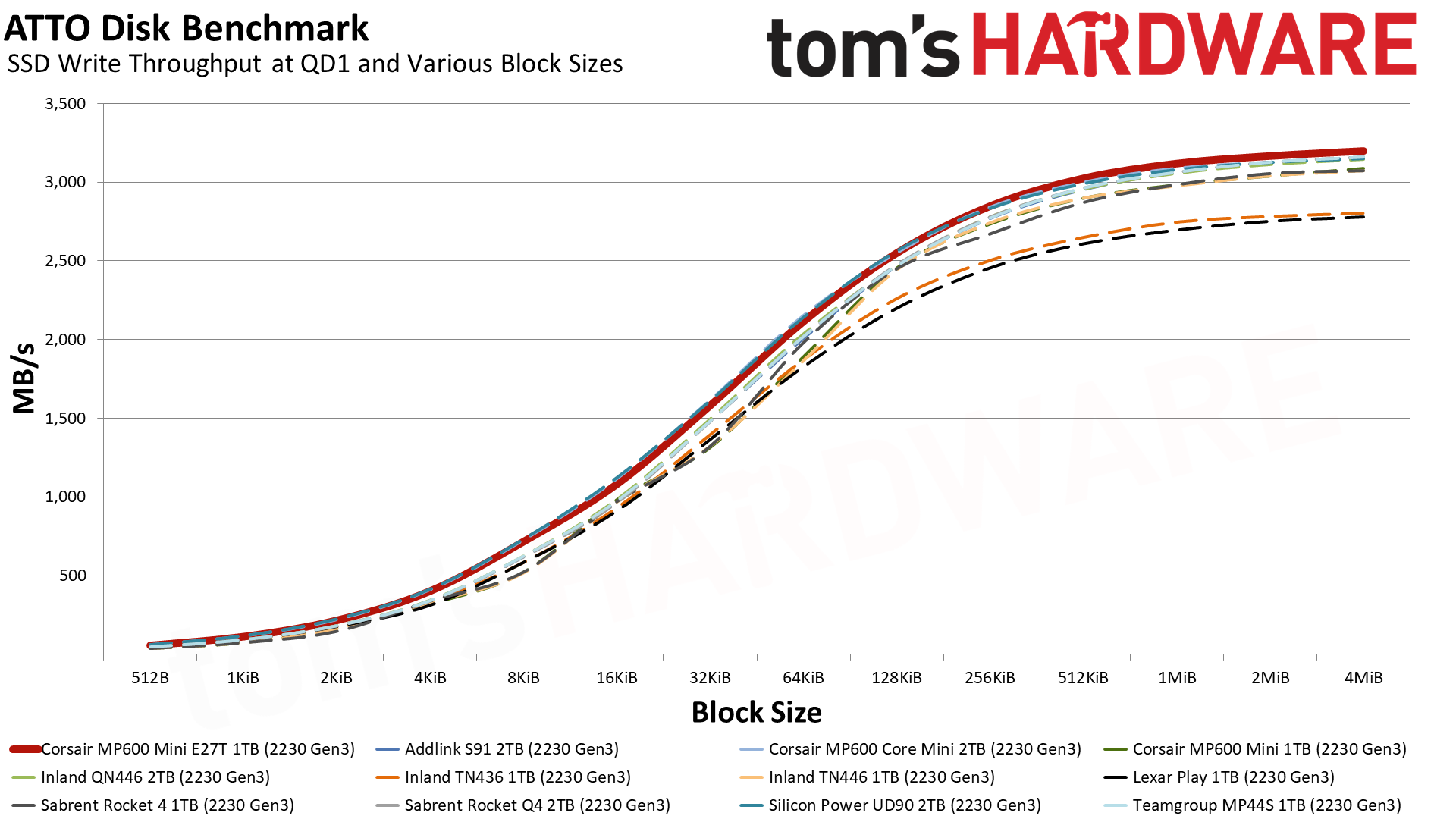


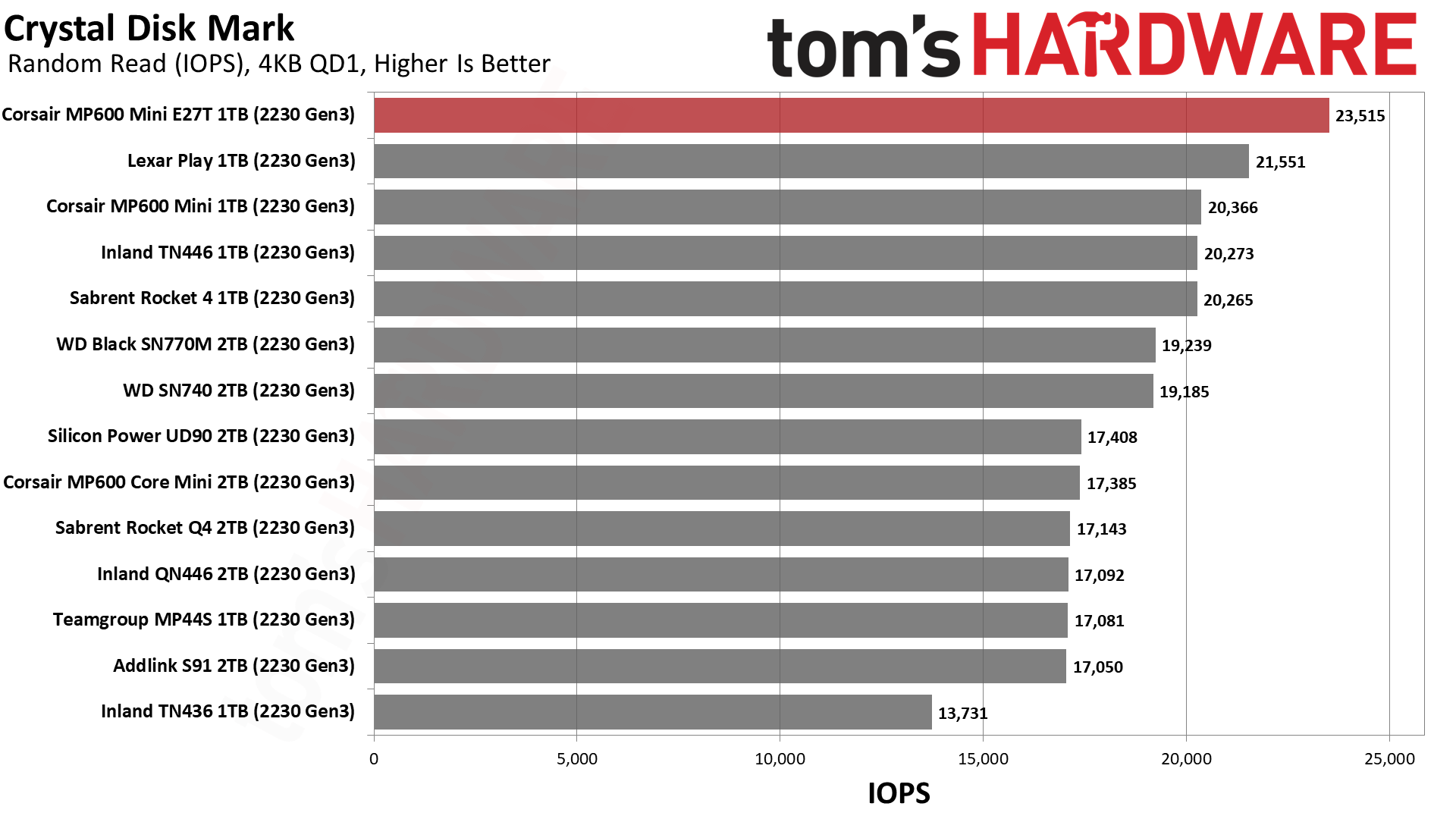
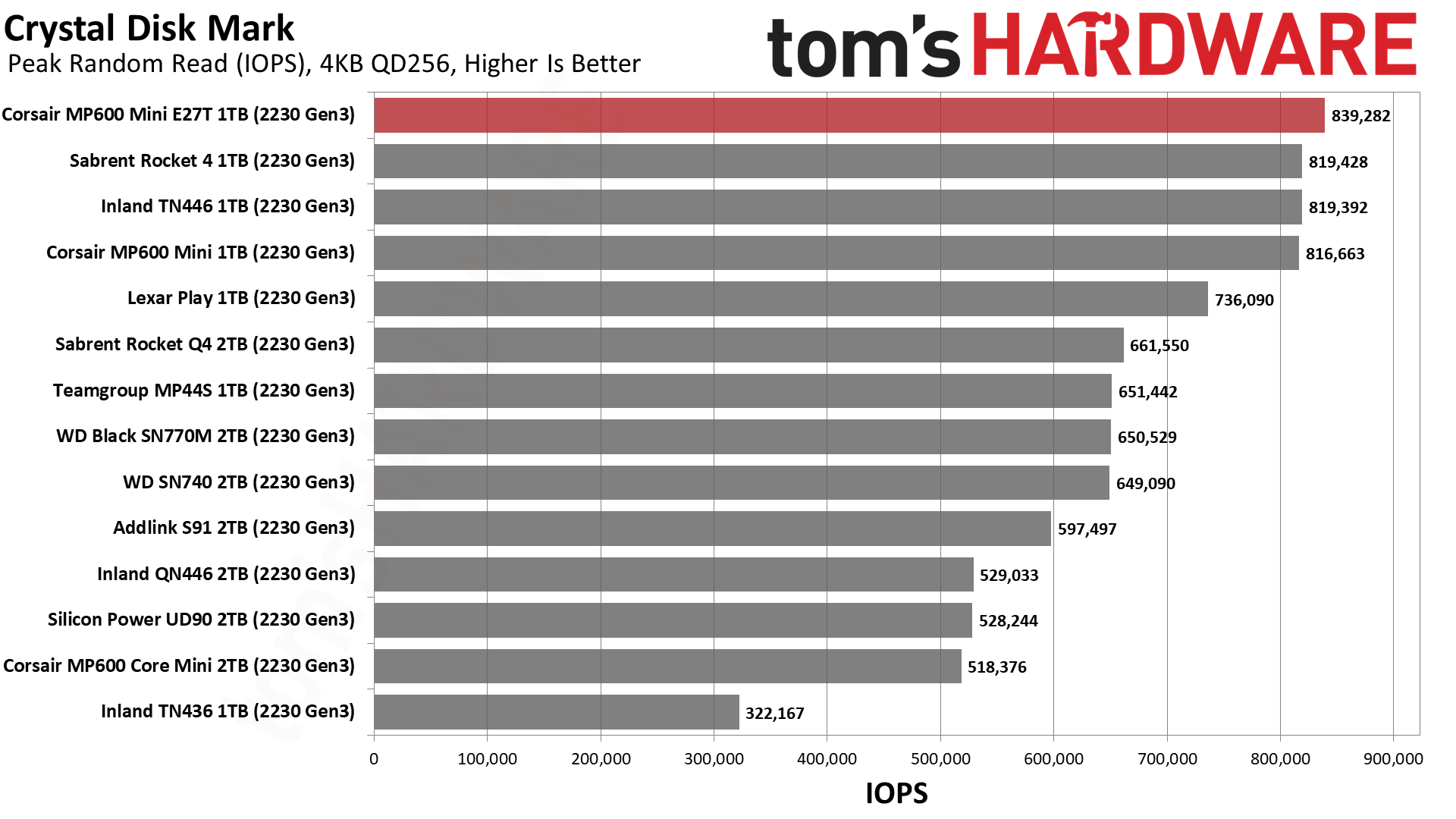
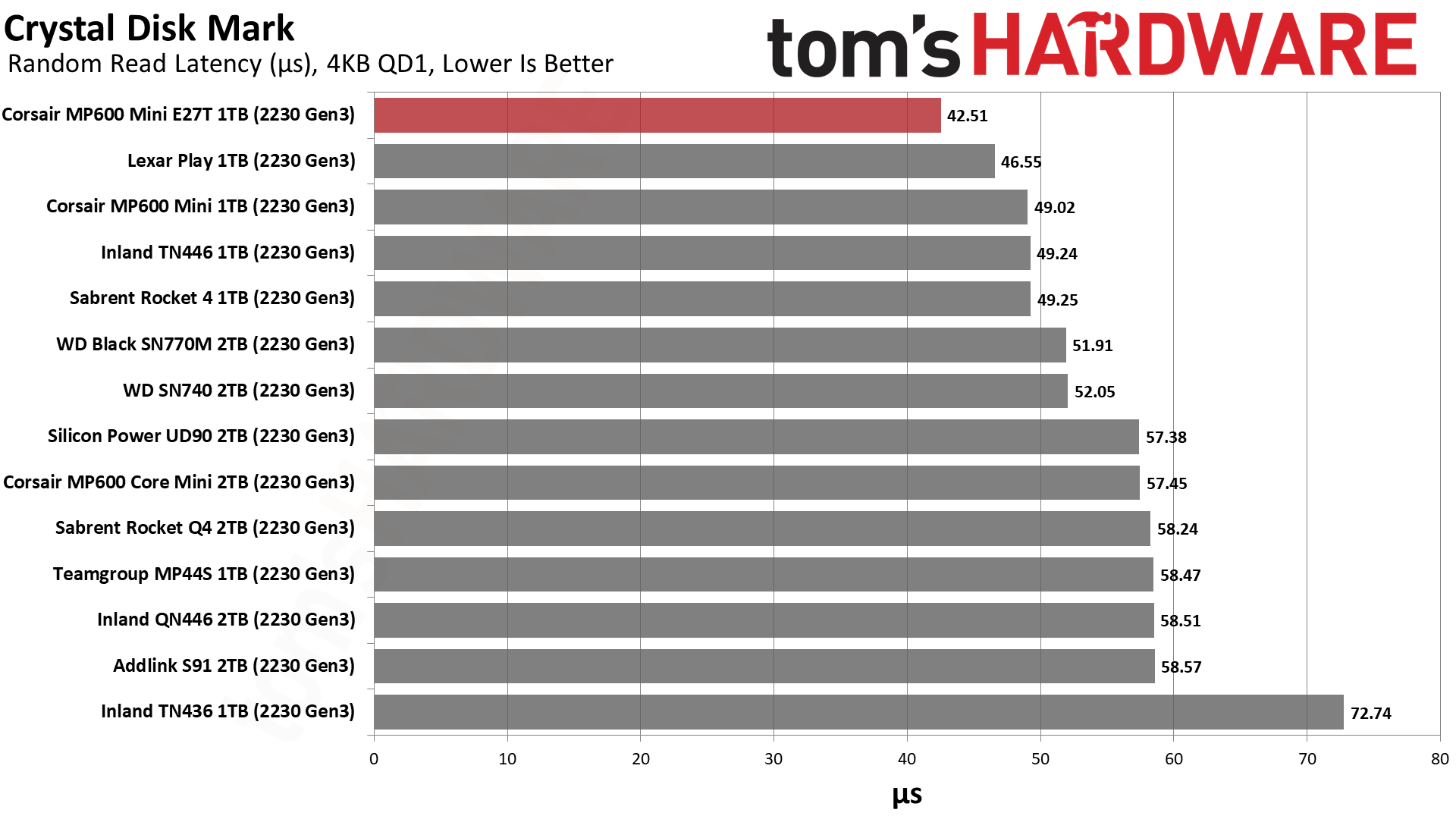
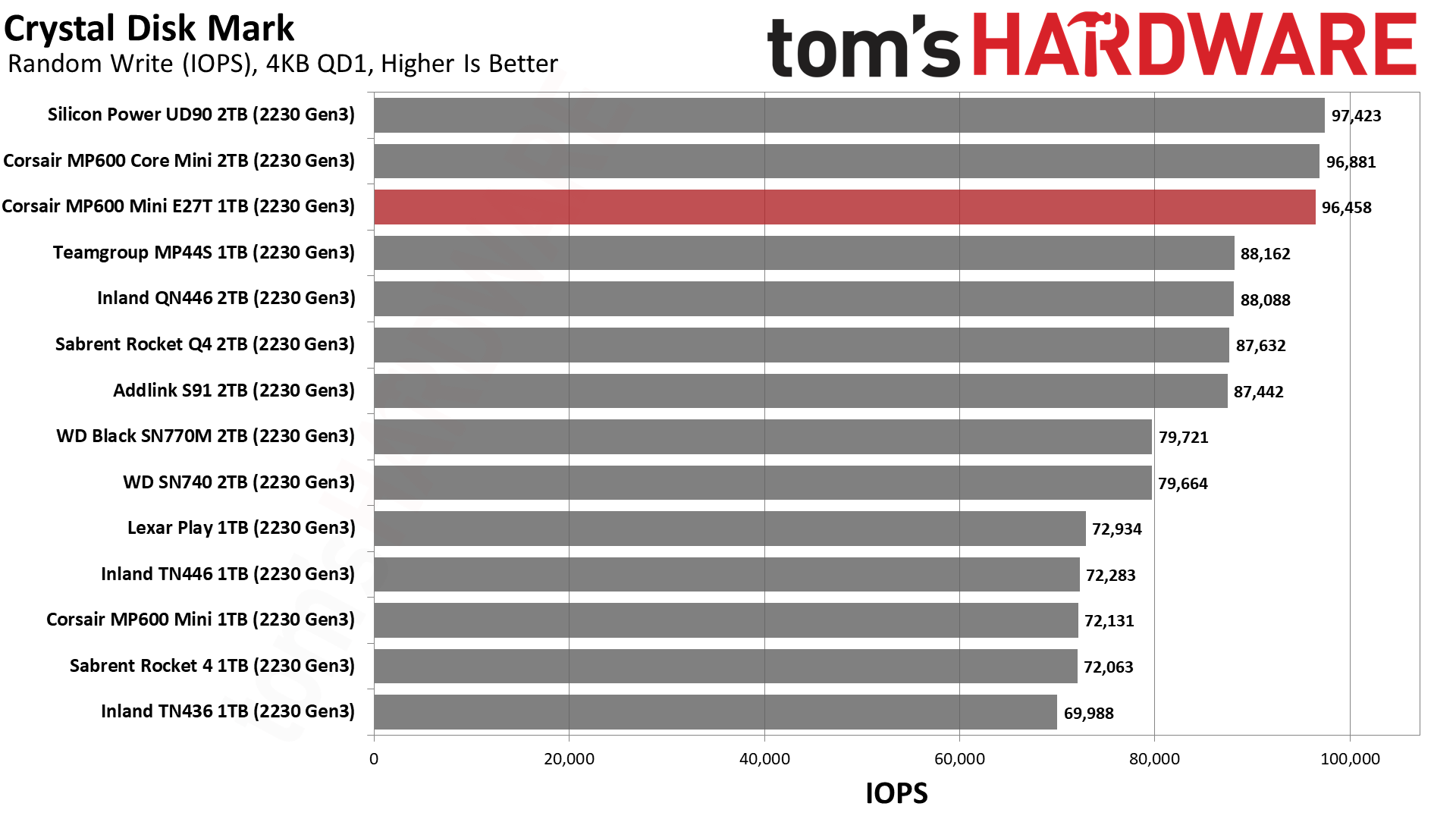
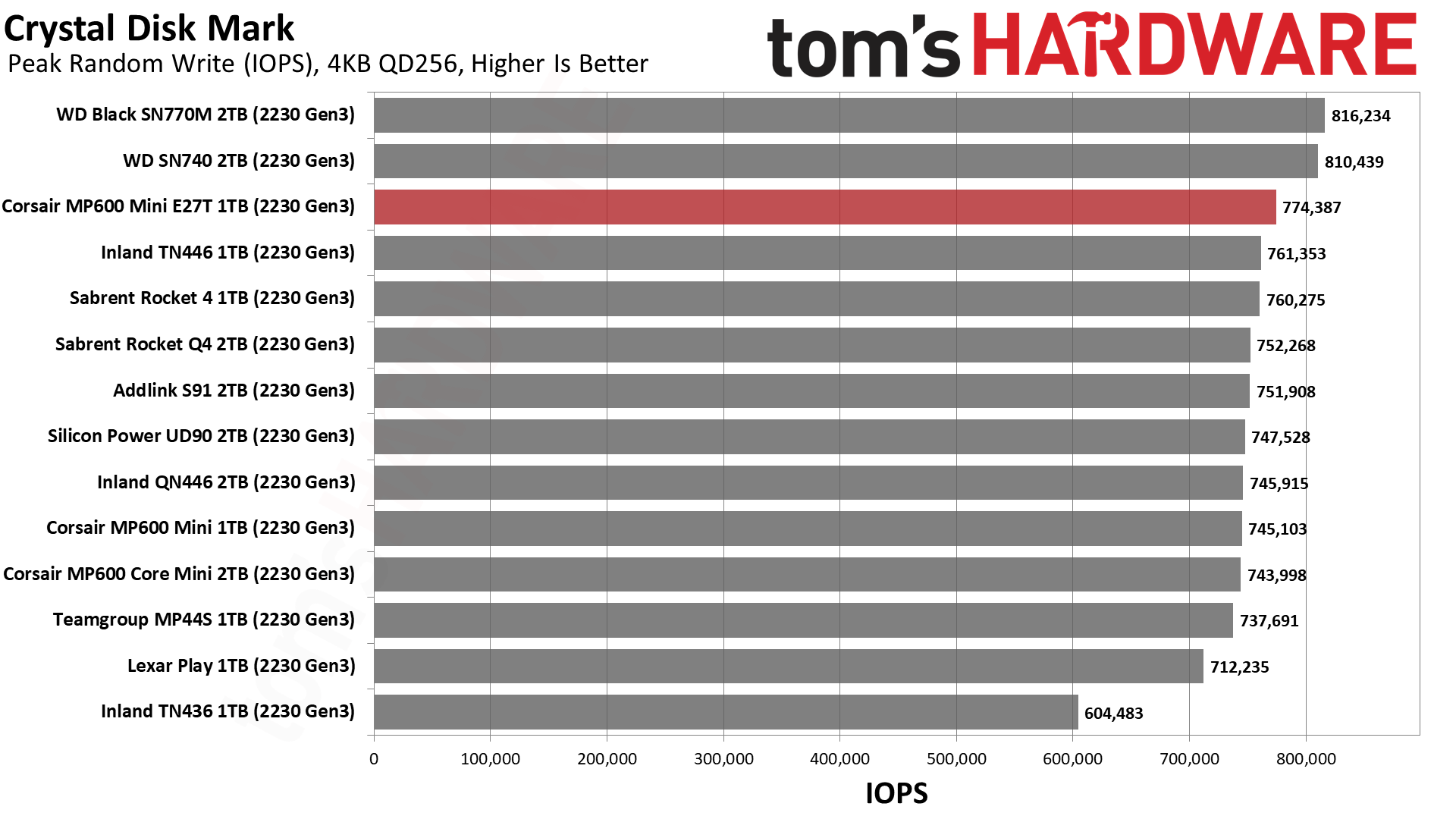
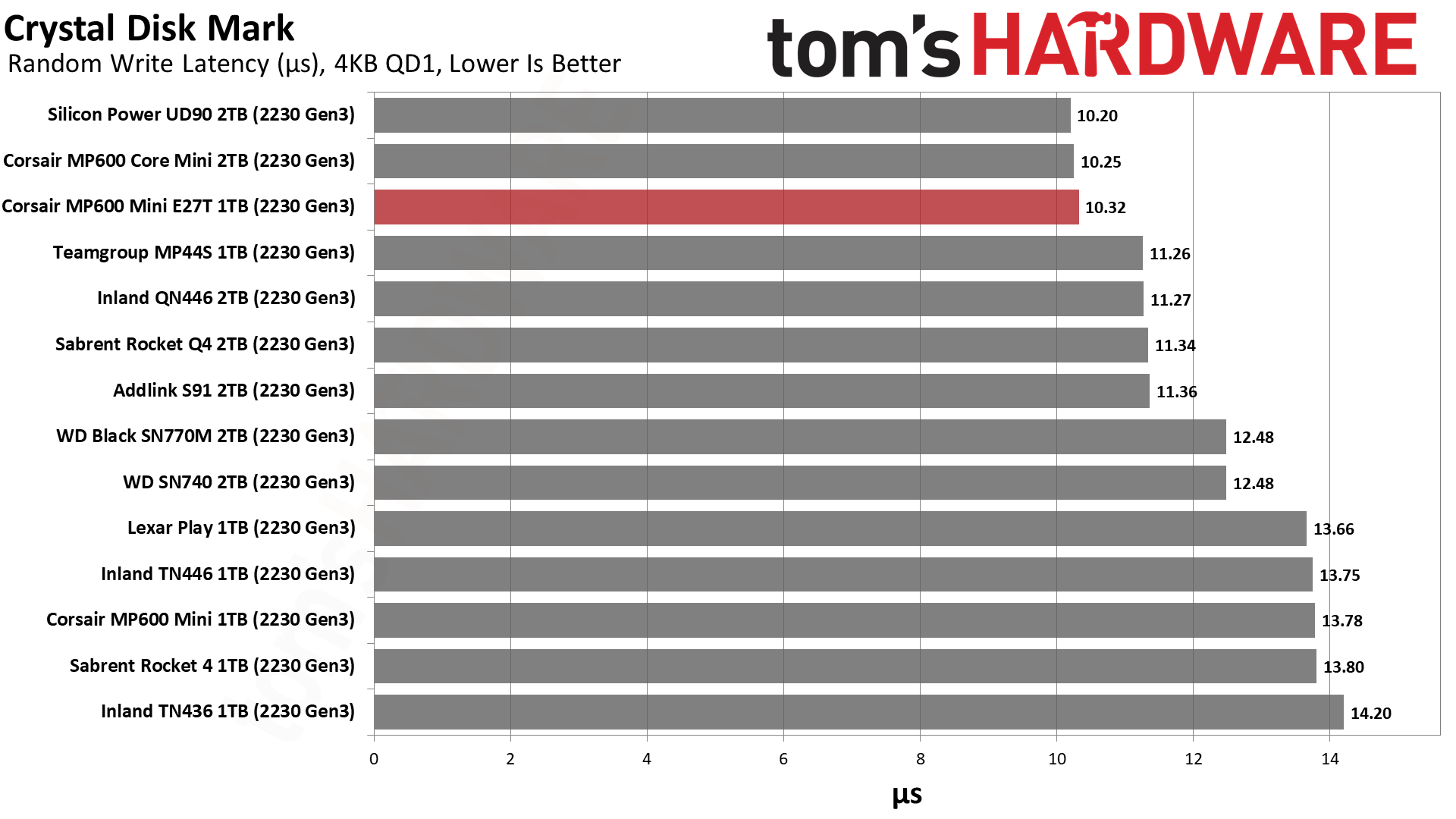
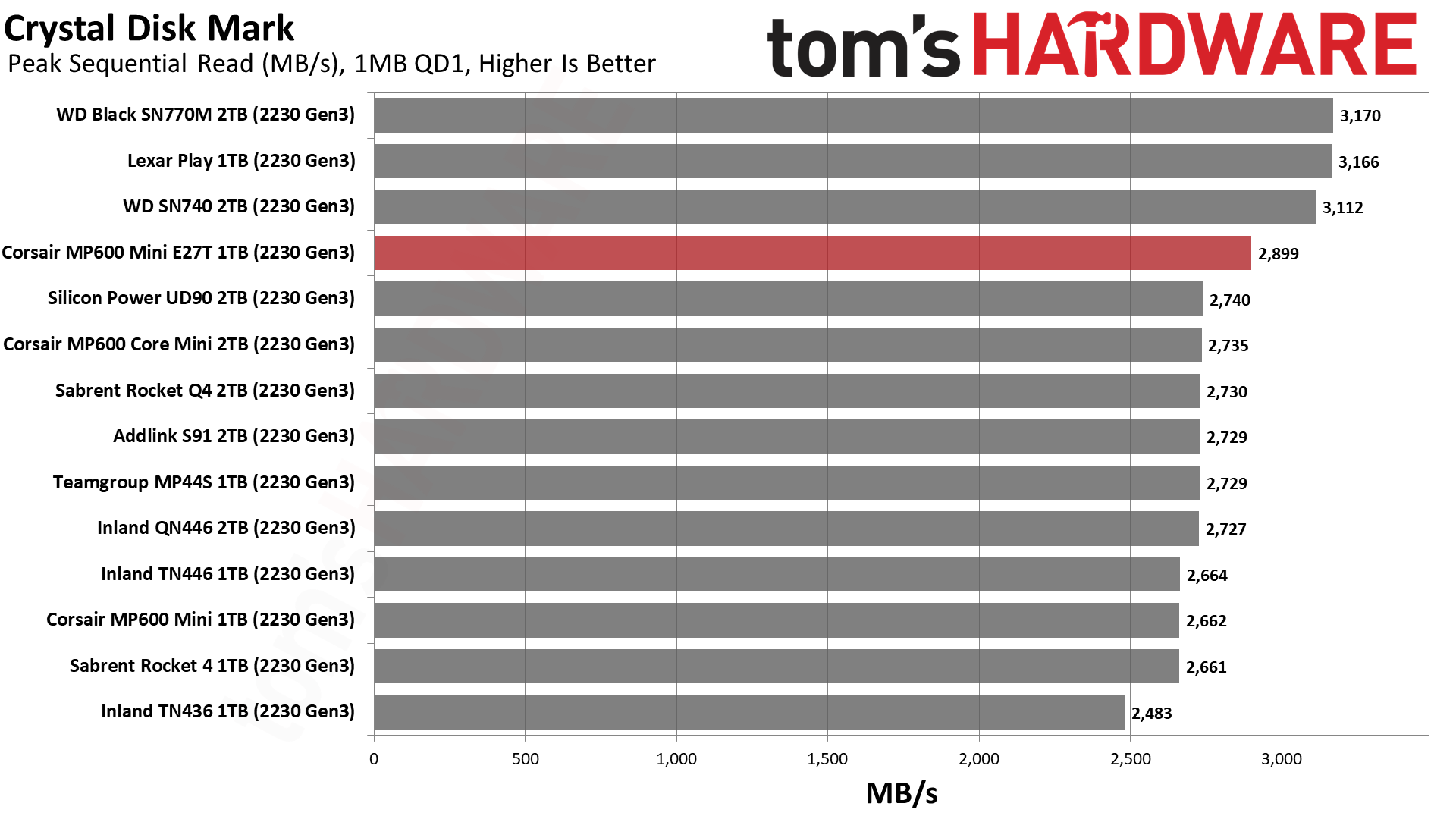
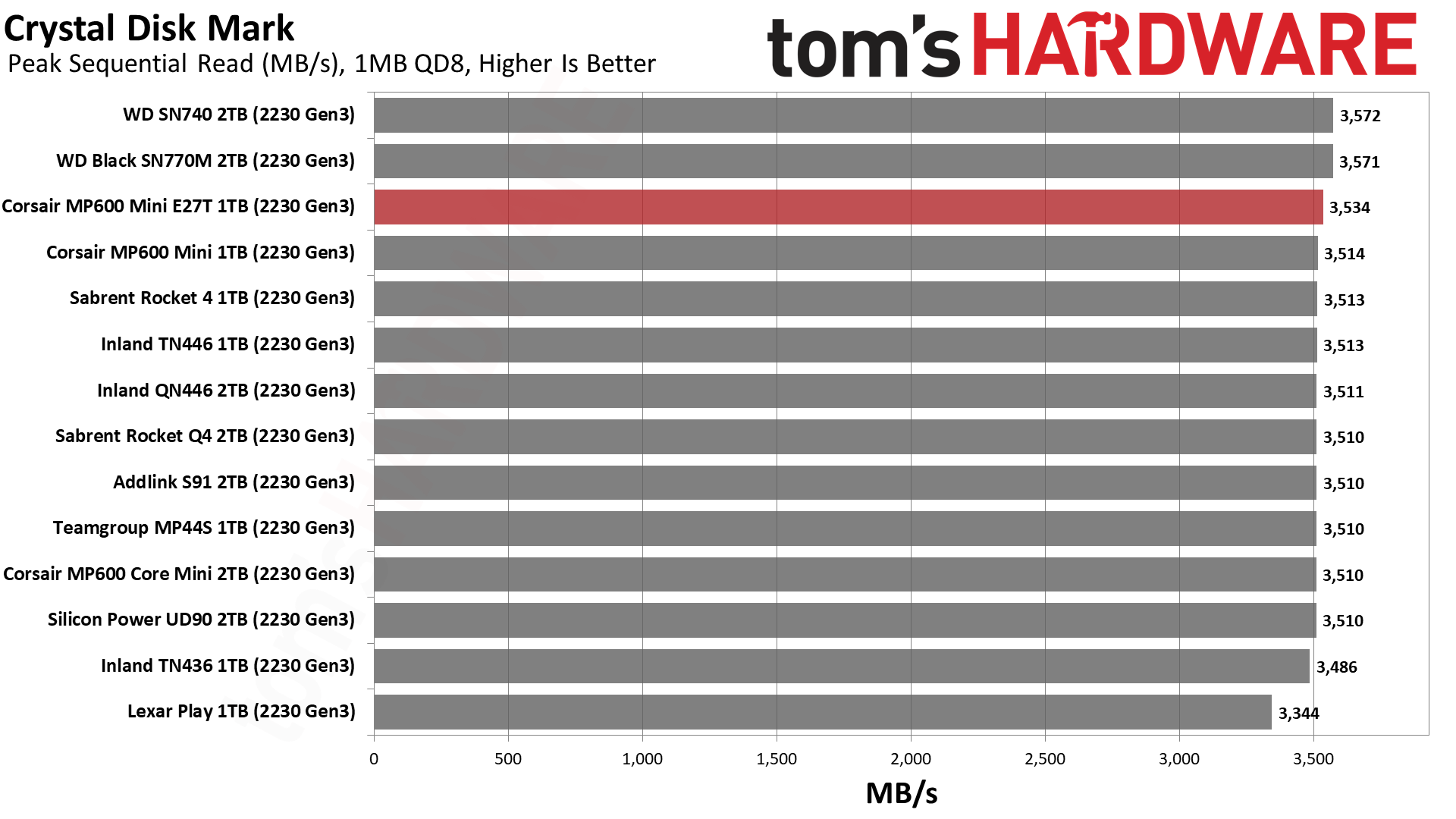
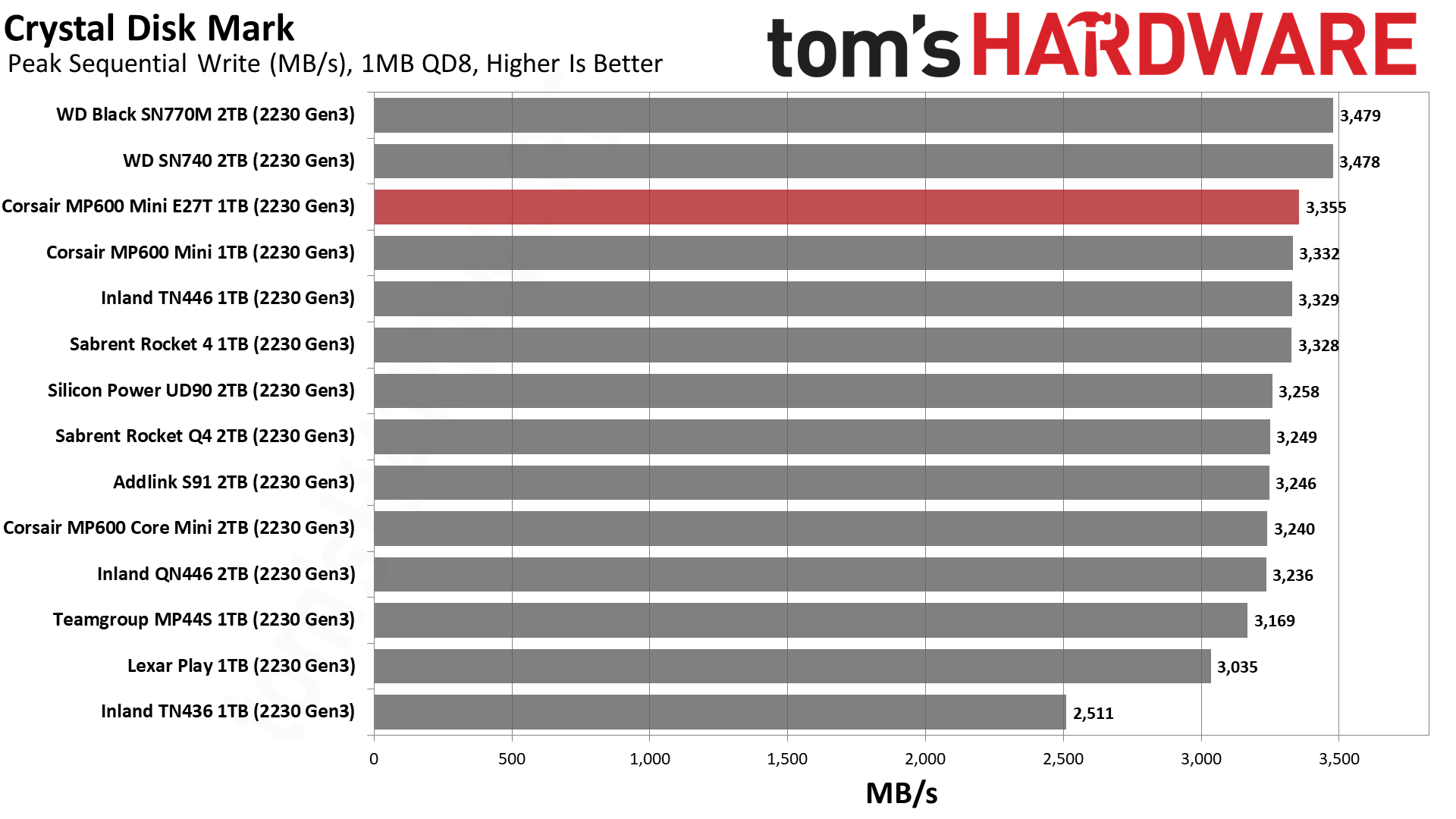
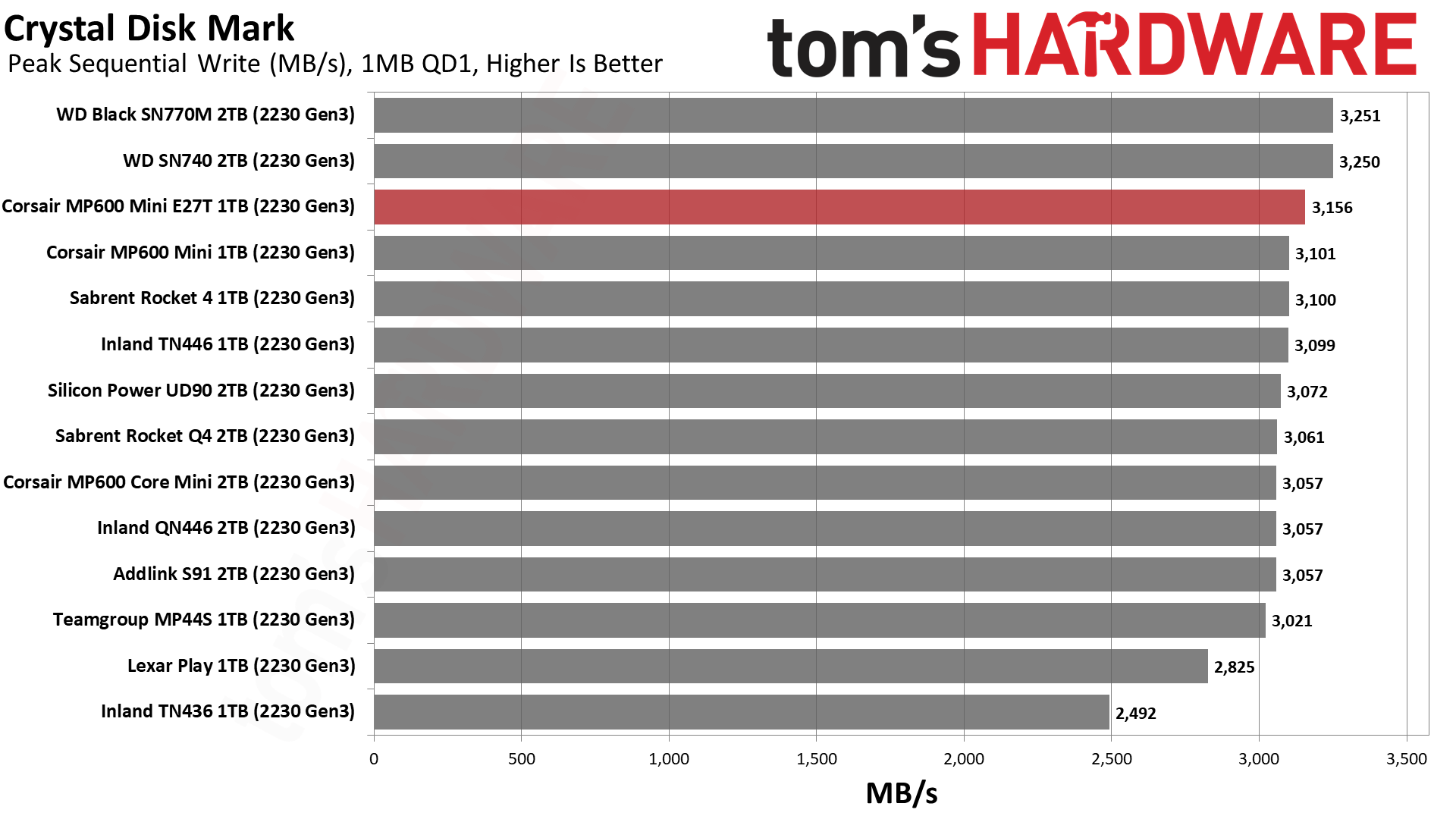
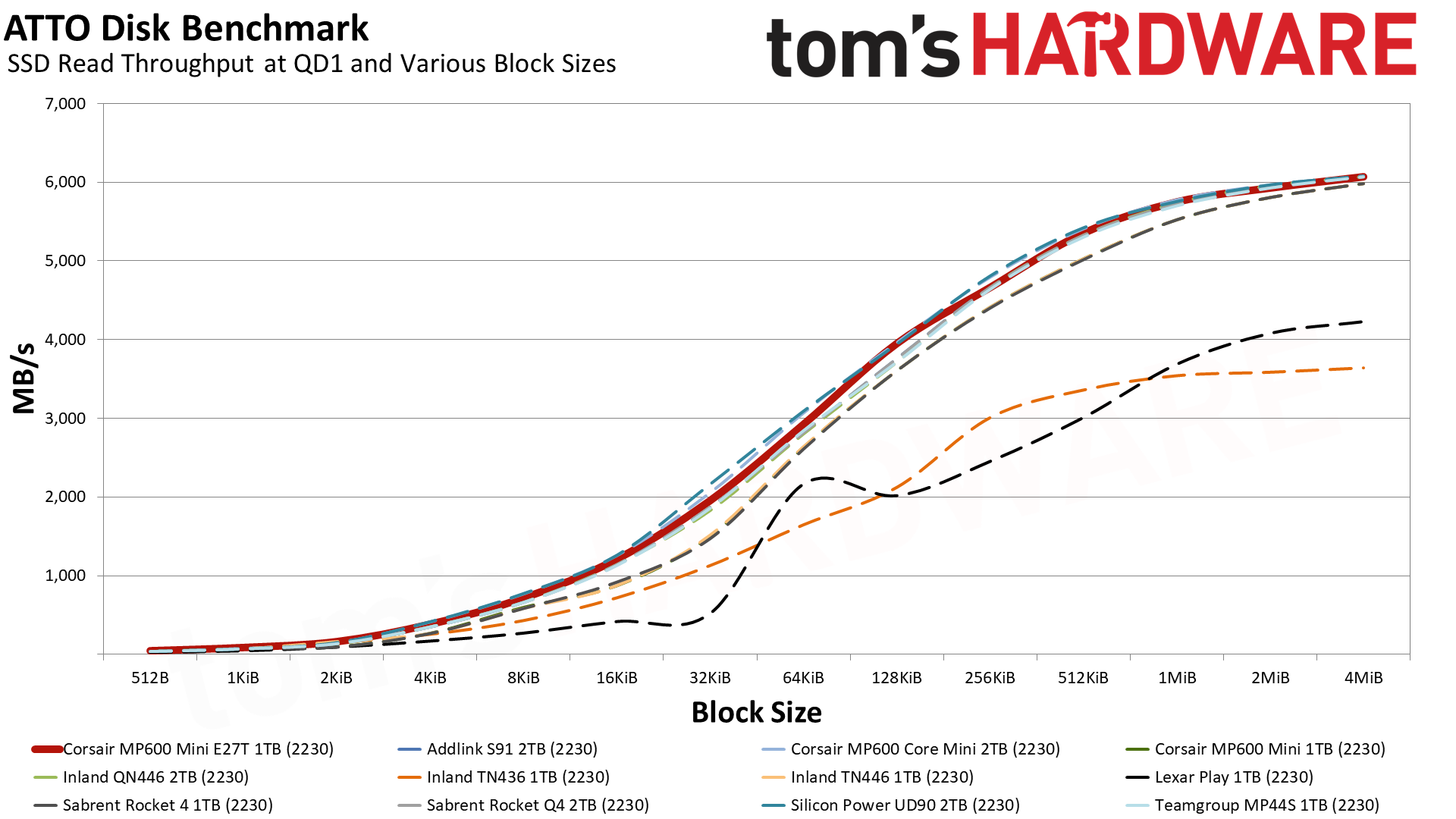


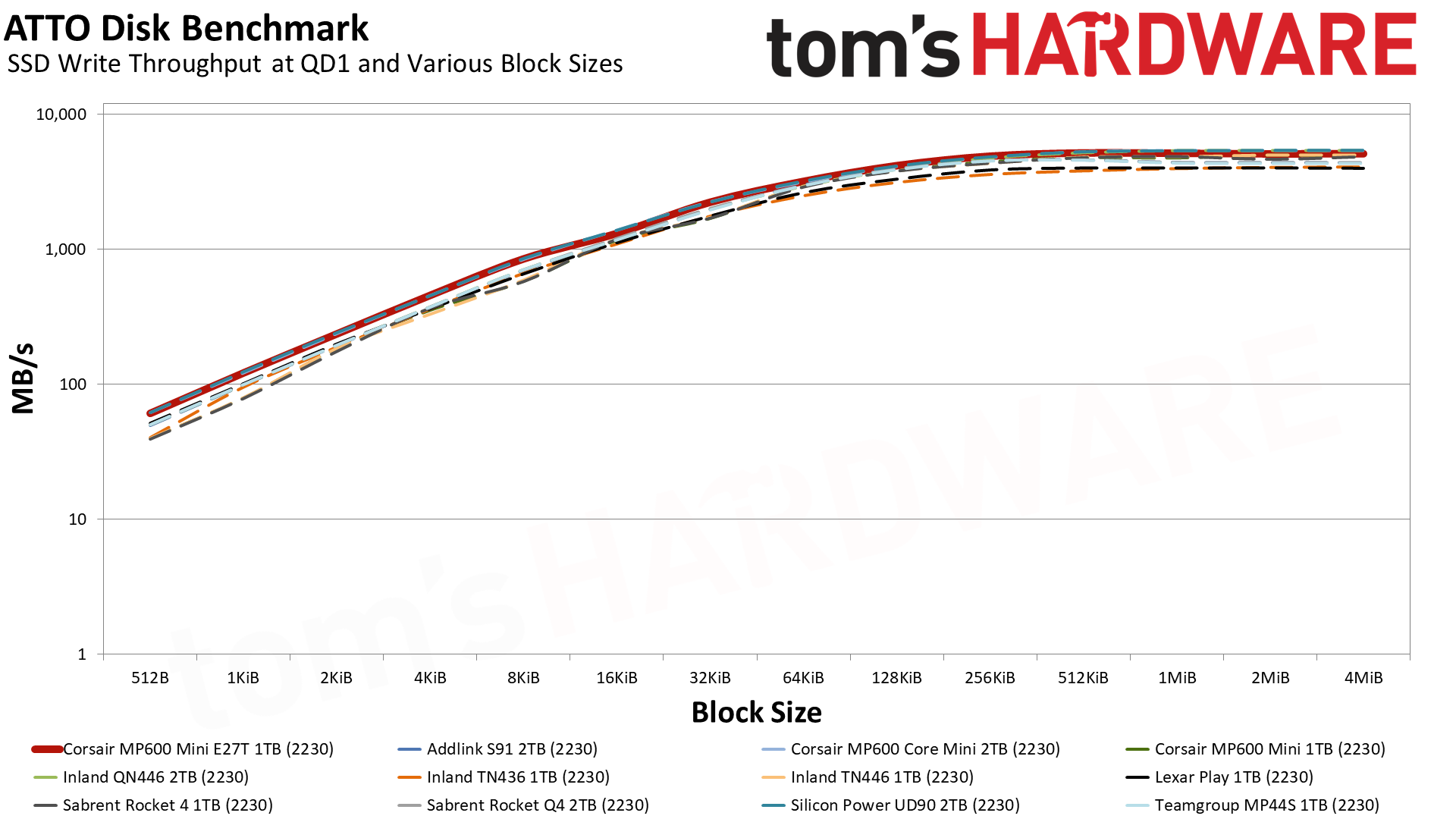

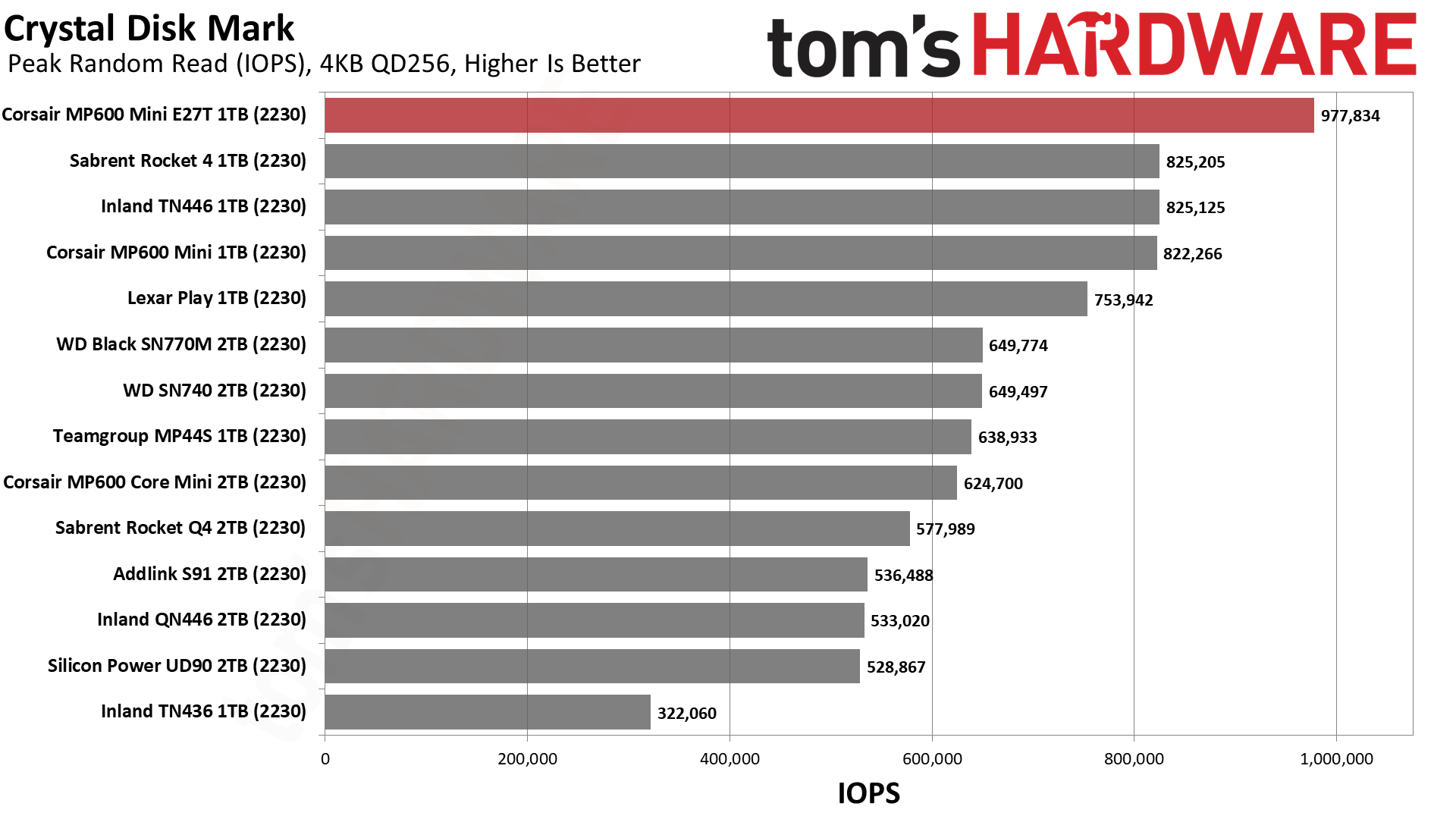

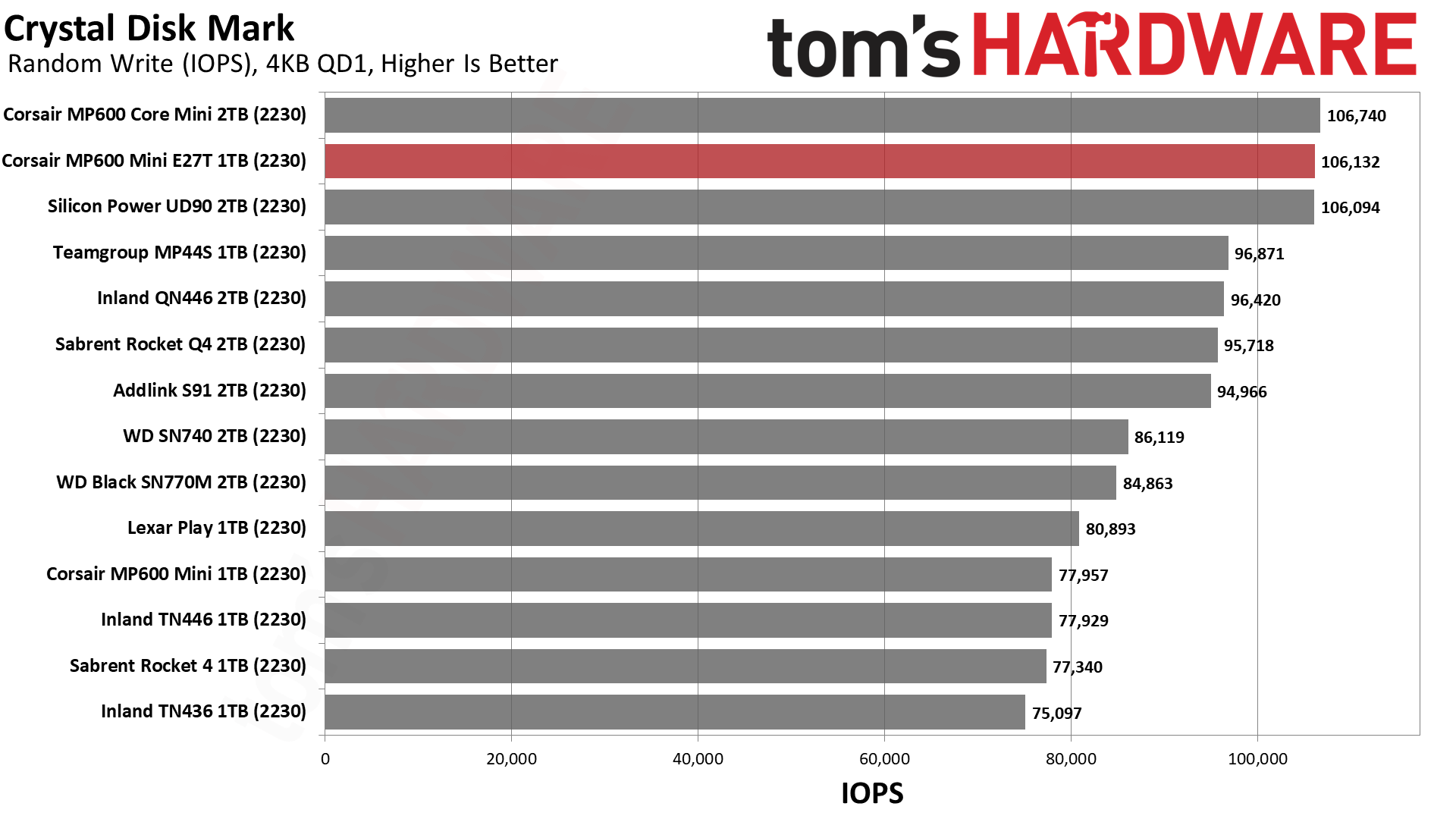



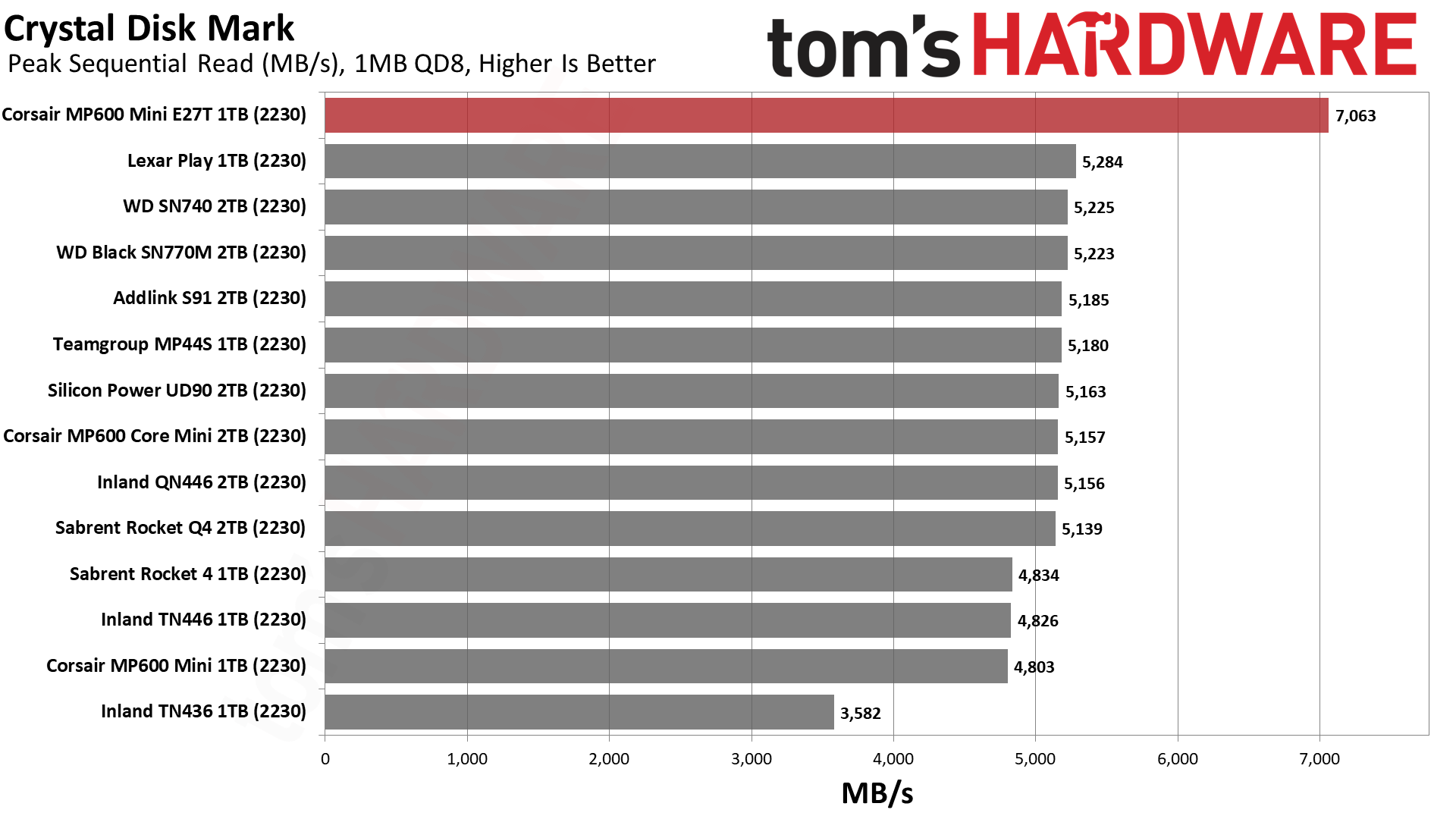
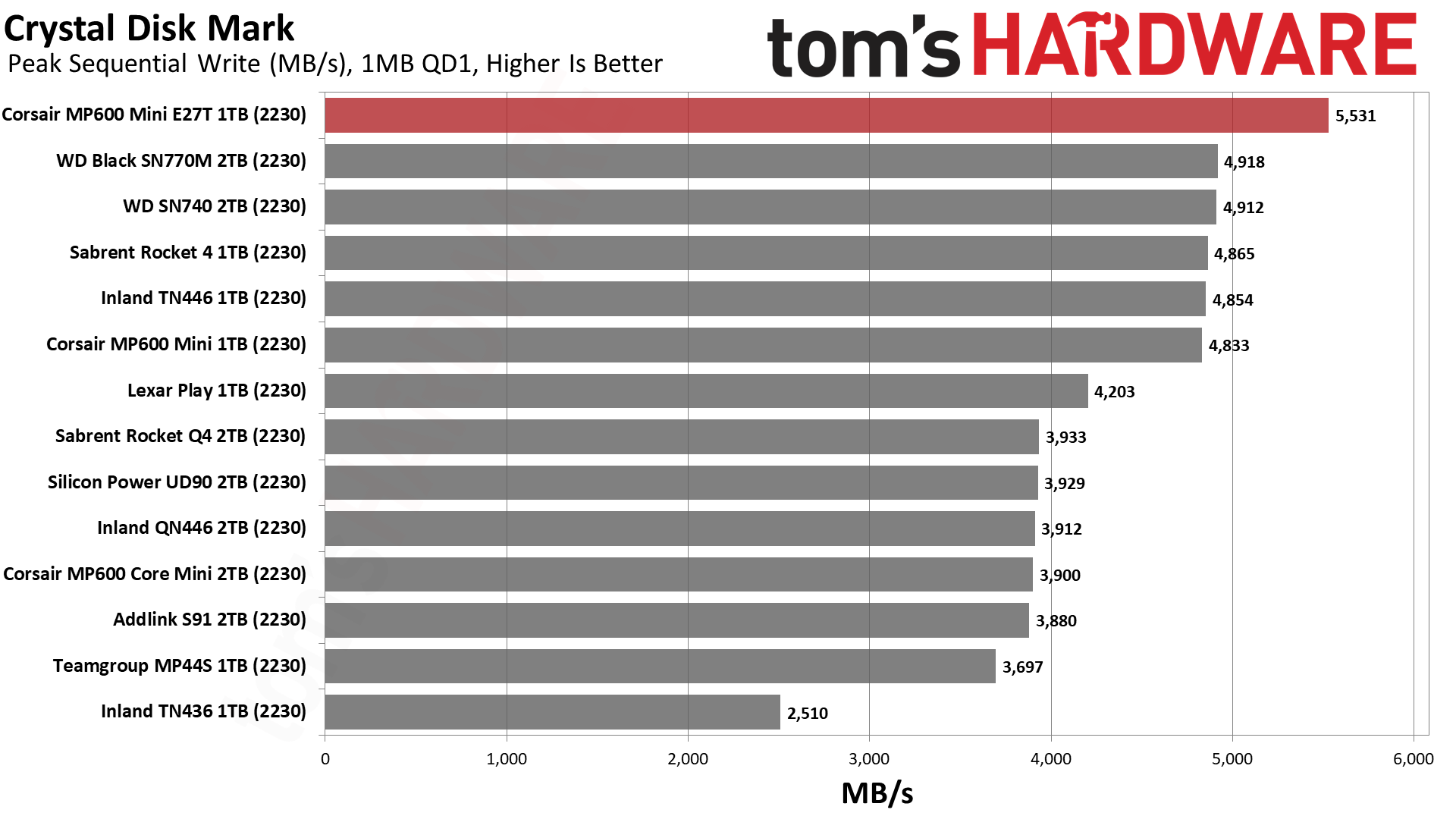
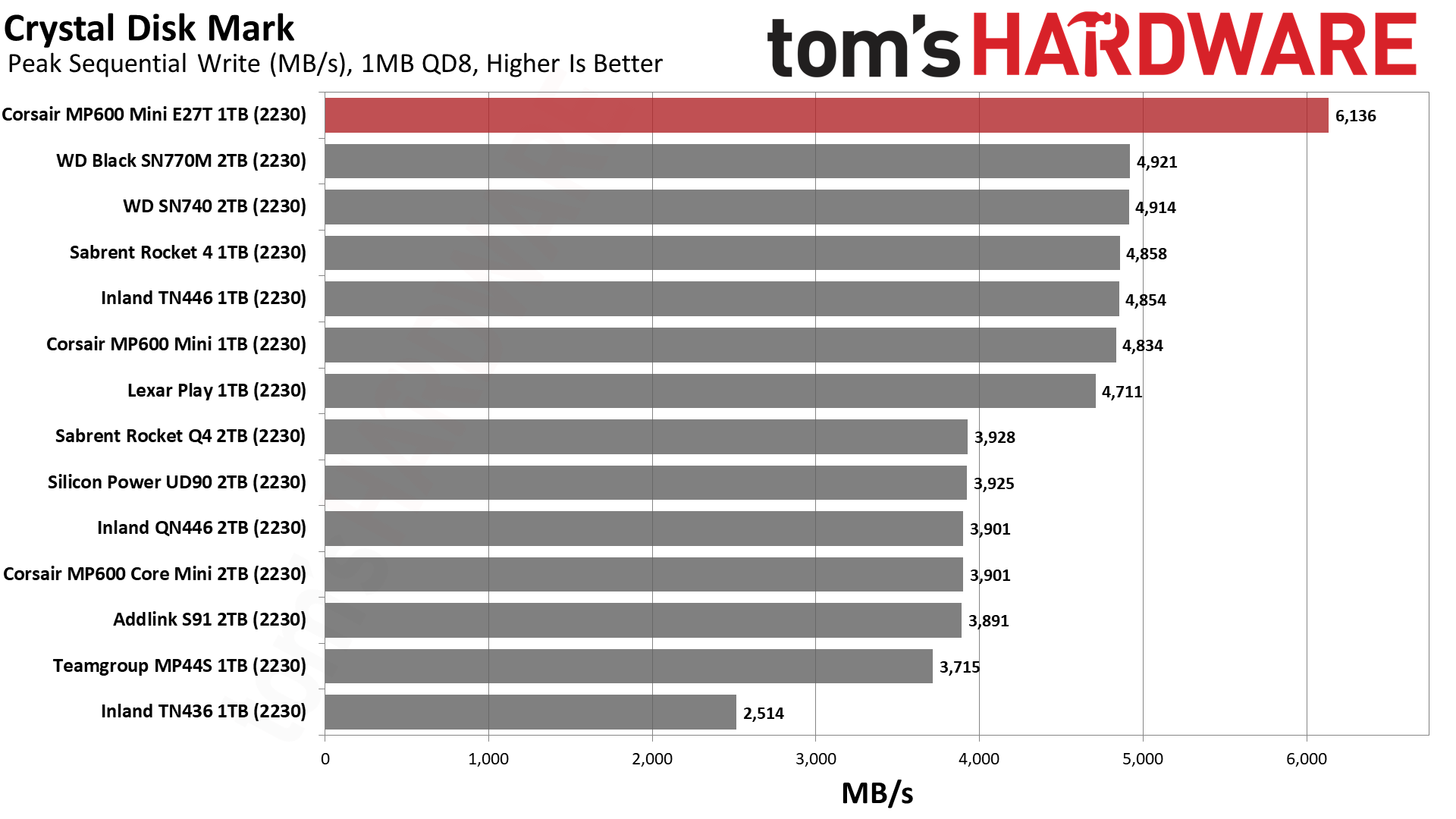
The MP600 Mini has no trouble maxing out the PCIe 3.0 interface, but it does eventually hit a wall with PCIe 4.0. We saw this with the MP600 Elite and Rocket 4, but it’s not a tragic shortcoming. Sequential write performance caps out at around the 512KiB block size, which aligns with the controller’s ability to interleave at 1TB. Performance should be similar at 2TB, though.
Sequential performance in CDM is mostly excellent with only a minor misstep when it comes to QD1 sequential reads, looking at PCIe 4.0 mode. The MP600 Mini falls behind WD’s drives in that case. Some workloads, including game loading, can rely on sequential reads, but for the most part any drive here will get the job done with little noticeable difference, except maybe the TN436. The MP600 Mini does require a 4.0 host to fully reach its potential.
When it comes to random 4KB QD1 performance, which is always highly sought after, the MP600 Mini is almost unparalleled. Its read and write latencies are excellent, matching or beating all the other drives we've tested. It's simply a monster of an SSD for 2230 devices.
Sustained Write Performance and Cache Recovery
Official write specifications are only part of the performance picture. Most SSDs implement a write cache, which is a fast area of (usually) pseudo-SLC programmed flash that absorbs incoming data. Sustained write speeds can suffer tremendously once the workload spills outside of the cache and into the "native" TLC or QLC flash.
We use Iometer to hammer the SSD with sequential writes for at least 15 minutes to measure both the size of the write cache and performance after the cache is saturated. We also monitor cache recovery via multiple idle rounds. This process shows the performance of the drive in various states as well as the steady state write performance.
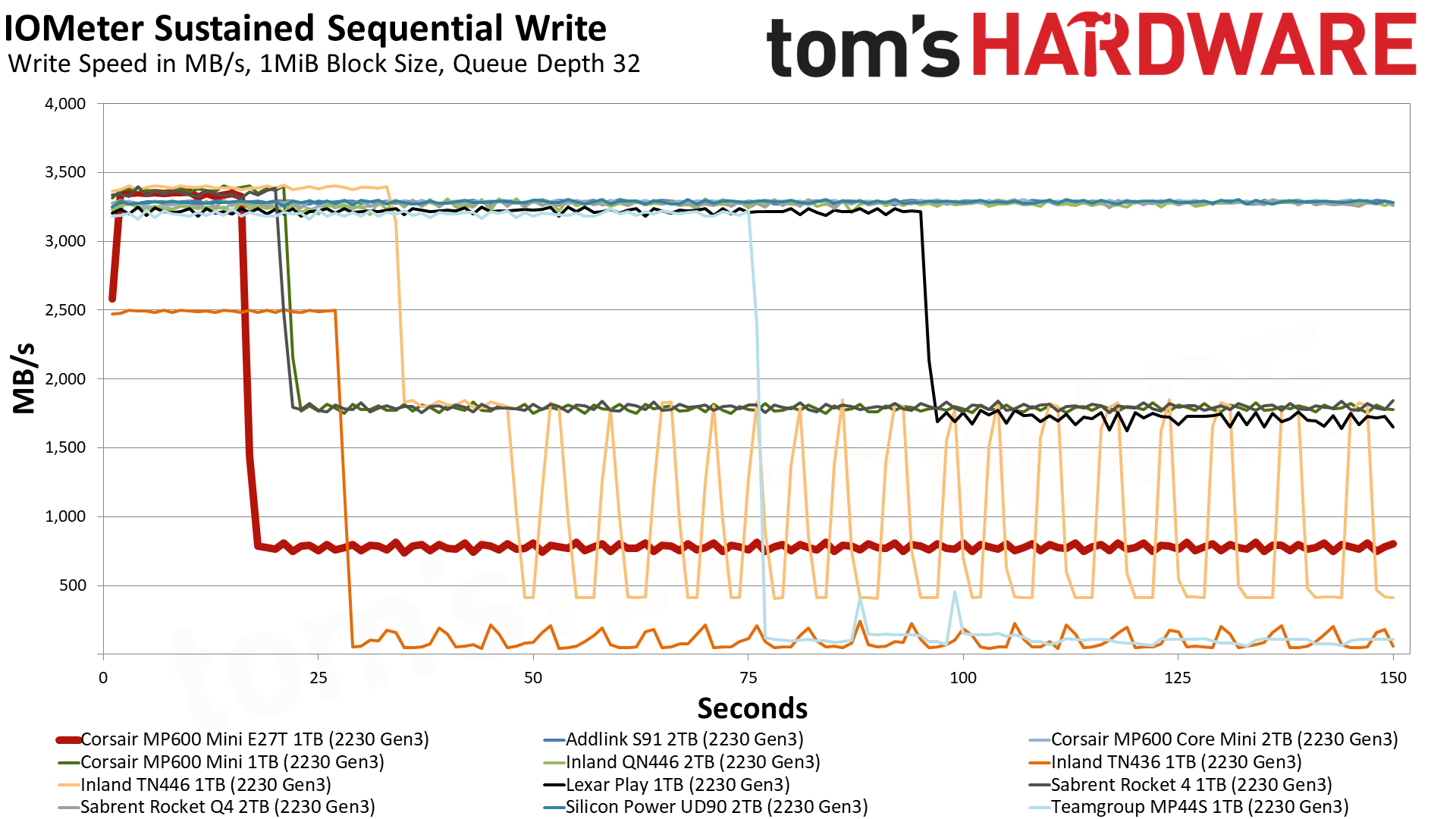

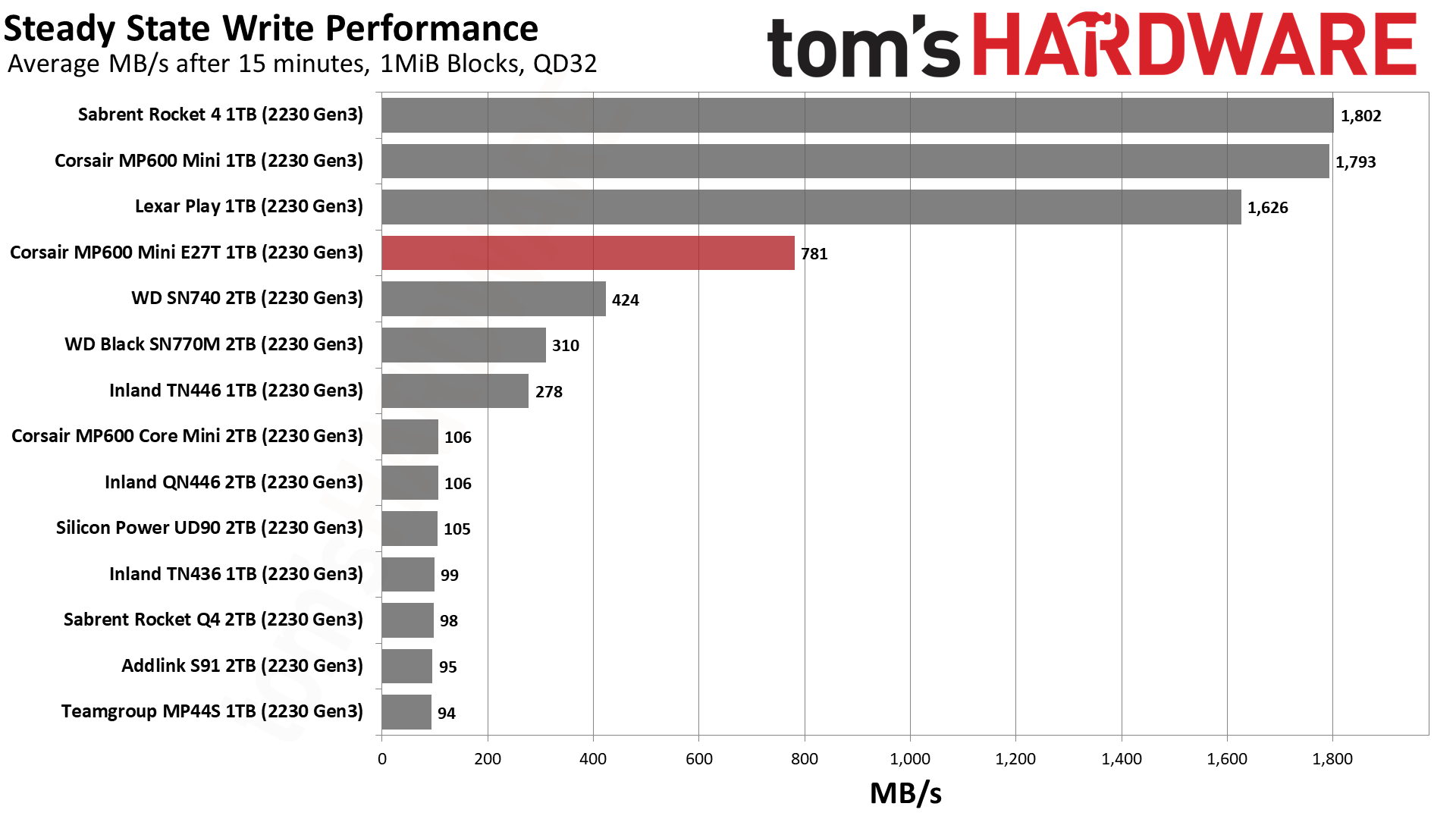

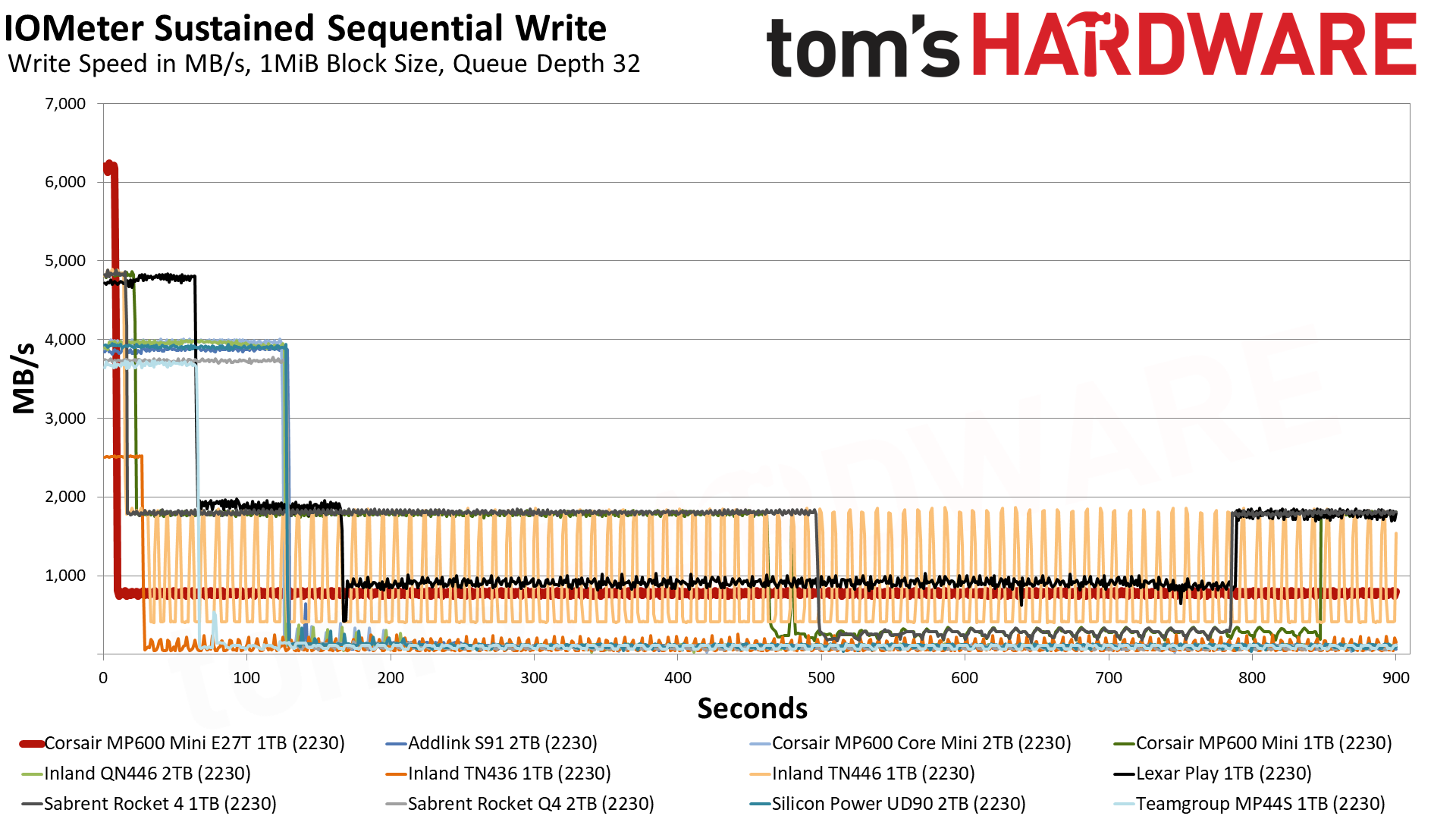
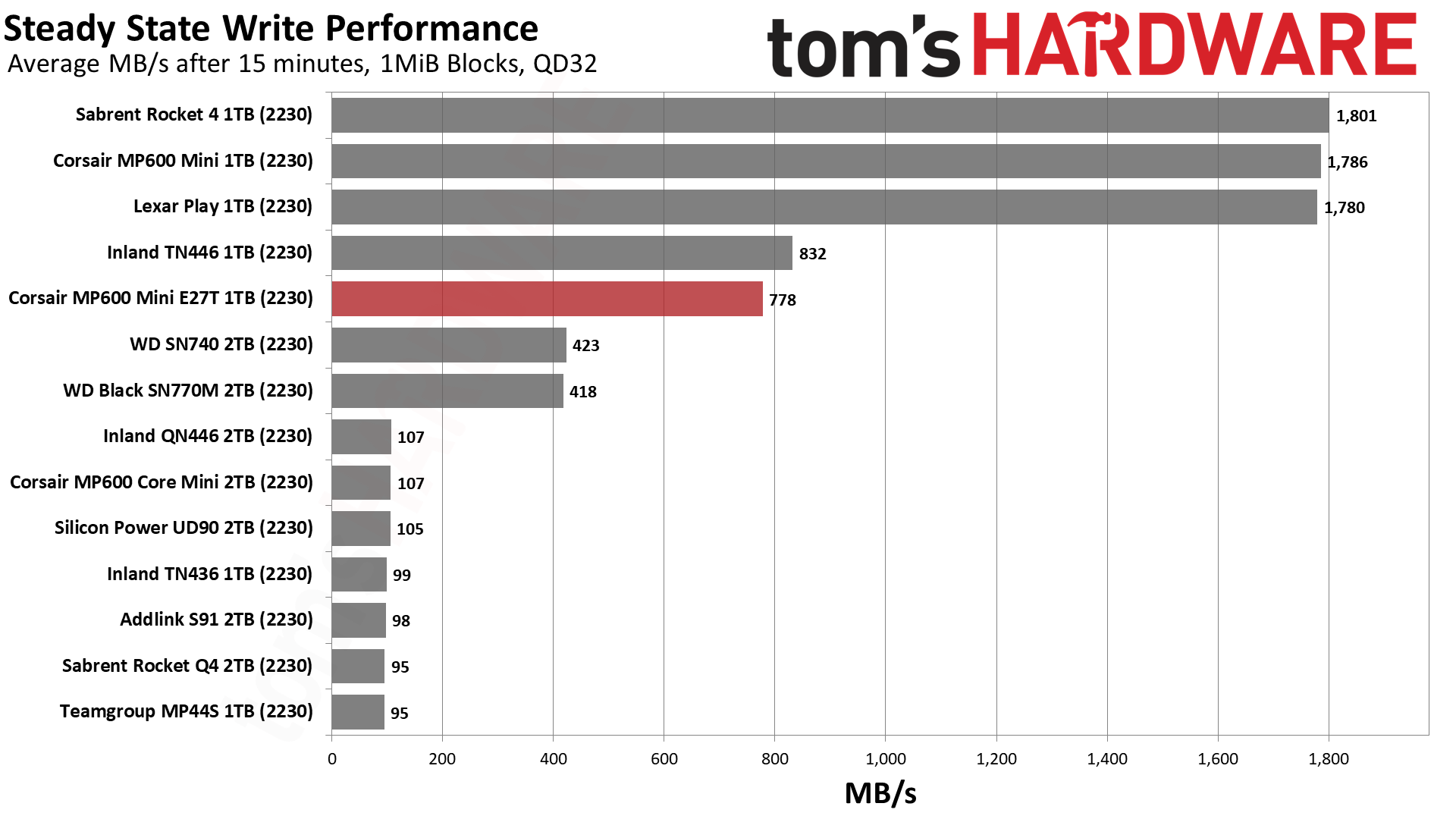
The 1TB MP600 Mini writes to the pSLC cache at up to about 3.2 GB/s in PCIe 3.0 mode and 5.9 GB/s in PCIe 4.0 mode. The cache is the same size either way, coming in at around 50GB. This matches our expectations from testing previous M.2 2280 drives with this hardware.
TLC or steady state performance lands at around 800 MB/s, a number assured because of the small cache. At 2TB, we would expect sustained writes to level out around 1.44 GB/s. The drive is not super eager to recover to pSLC mode, probably because of its consistent post-cache performance and by design to balance performance and endurance.
Power Consumption and Temperature
We use the Quarch HD Programmable Power Module to gain a deeper understanding of power characteristics. Idle power consumption is an important aspect to consider, especially if you're looking for a laptop upgrade as even the best ultrabooks can have mediocre stock storage. Desktops may be more performance-oriented with less support for power-saving features, so we show the worst-case.
Some SSDs can consume watts of power at idle while better-suited ones sip just milliwatts. Average workload power consumption and max consumption are two other aspects of power consumption but performance-per-watt, or efficiency, is more important. A drive might consume more power during any given workload, but accomplishing a task faster allows the drive to drop into an idle state more quickly, ultimately saving energy.
For temperature recording we currently poll the drive’s primary composite sensor during testing with a 21-22°C ambient. Our testing is rigorous enough to heat the drive to a realistic ceiling temperature.



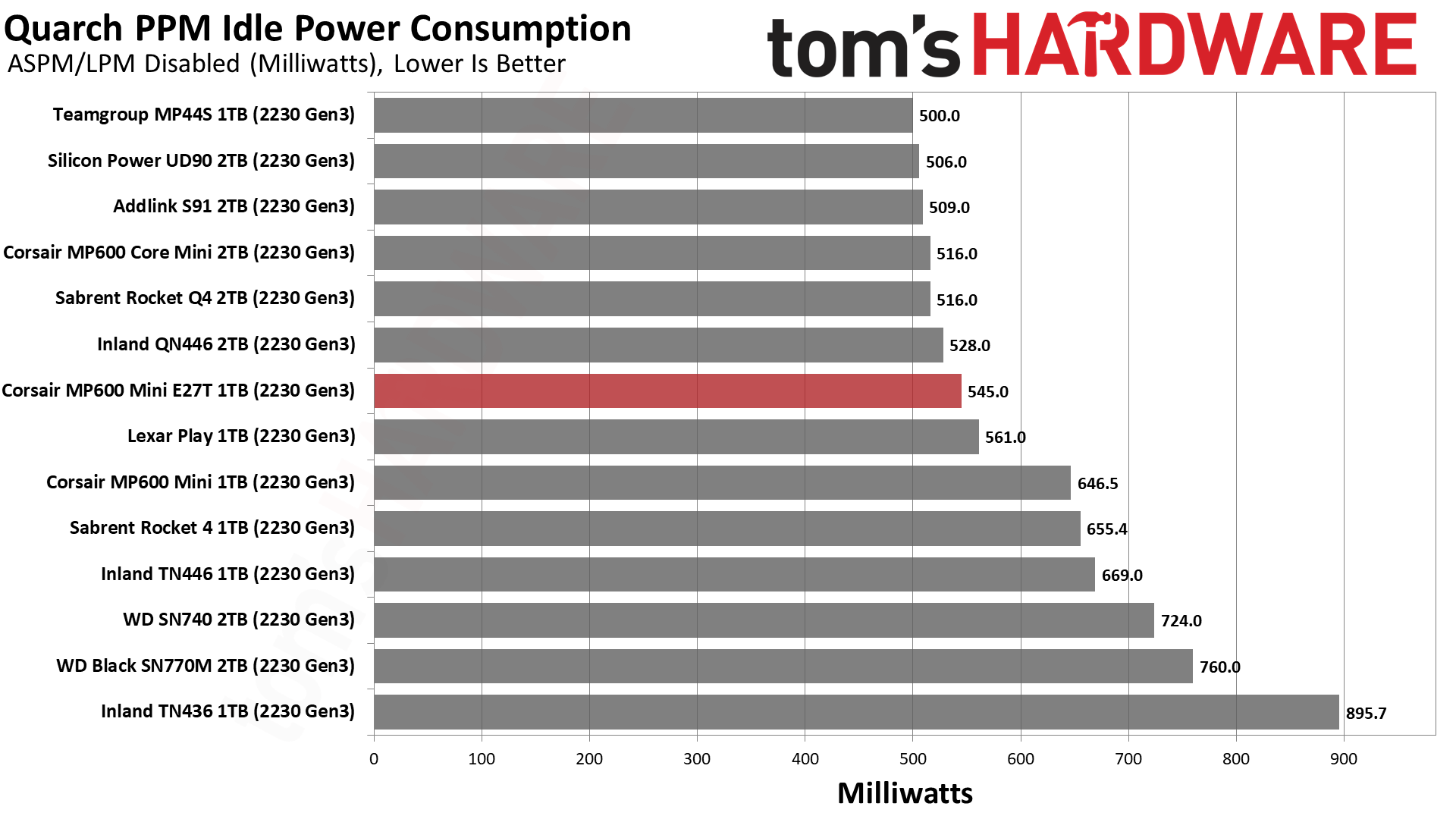

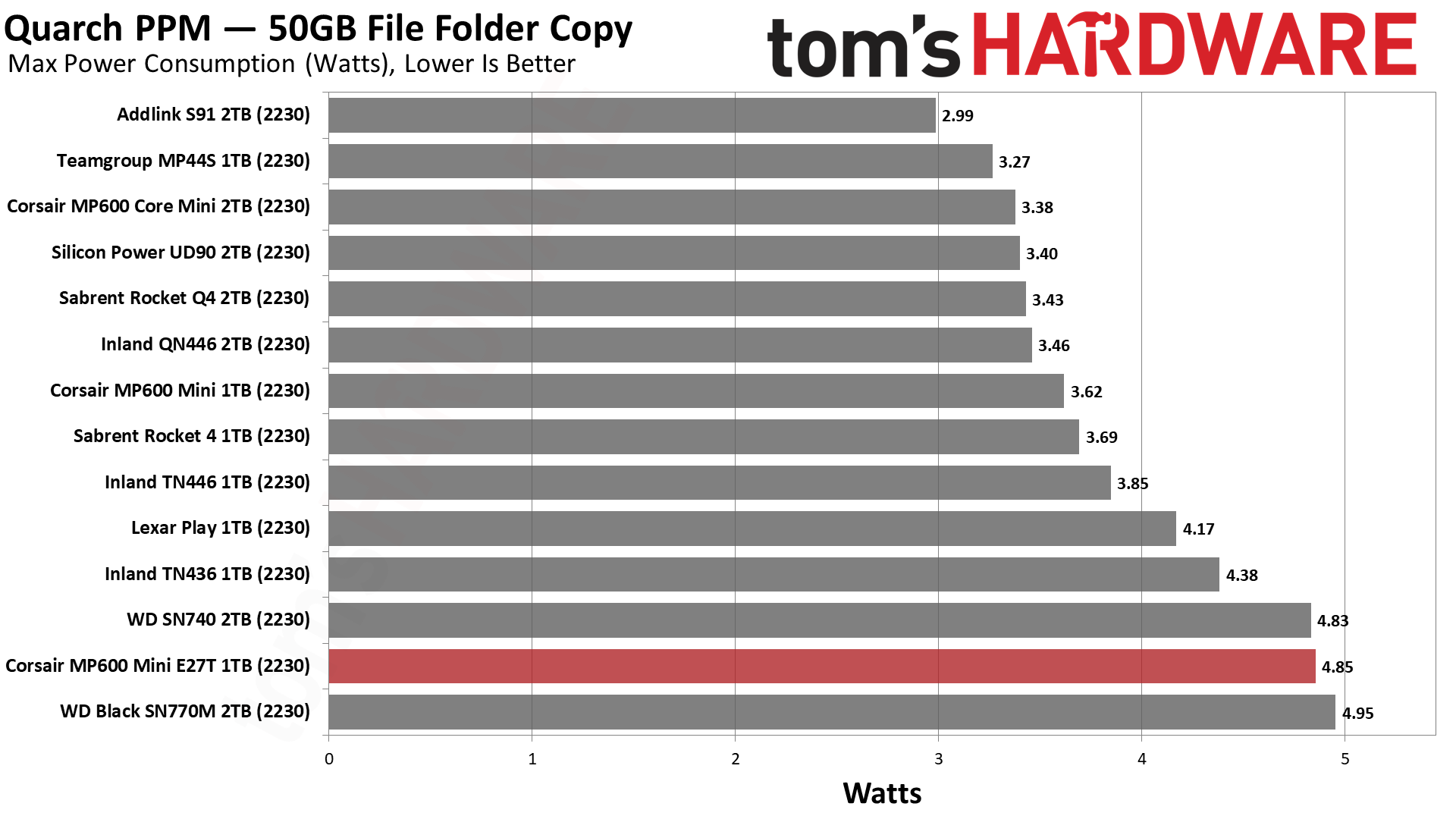
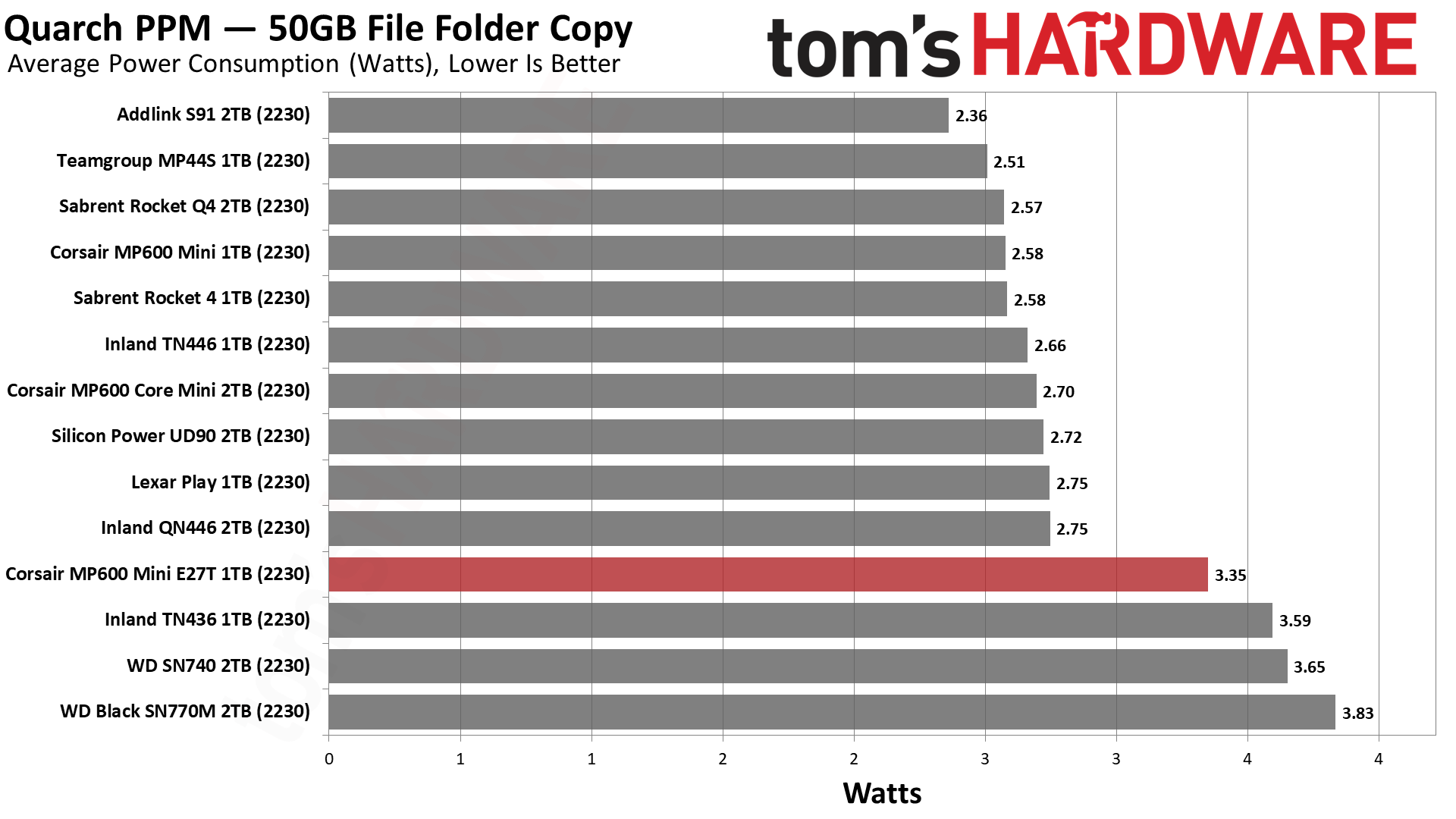
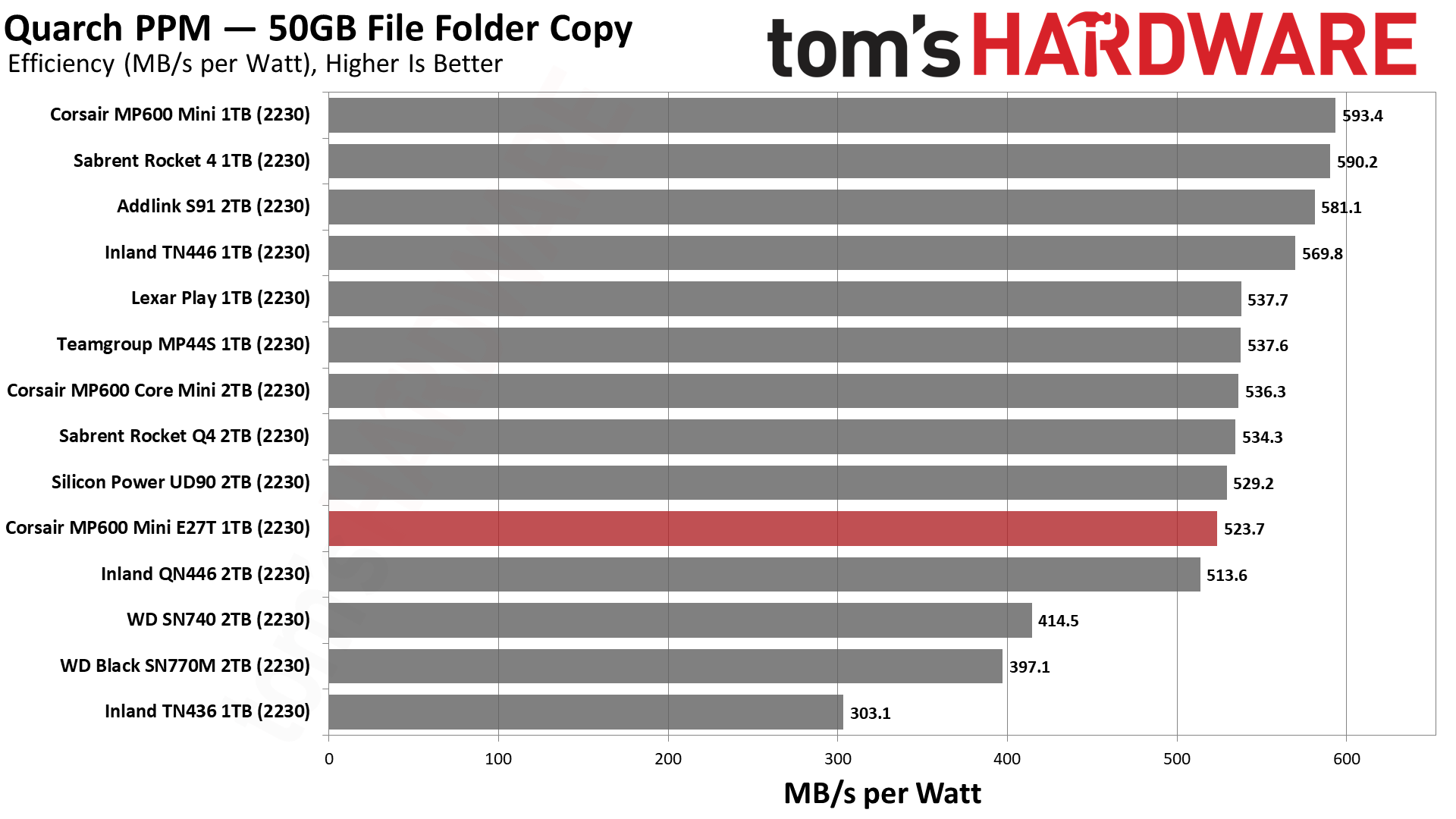
When we talk of portable gaming systems, we definitely want high power efficiency. Lower power consumption means better battery life and less heat production. These are good things for this form factor. Luckily, the MP600 Mini is reasonably efficient. It’s not setting any records, but it’s clearly better than WD’s drives. This would extend to 2TB, which makes it the undisputed champion at that capacity if you want TLC flash. If you only need 1TB and favor all-around performance, the MP600 Mini is still efficient enough, regardless of PCIe mode.
The MP600 Mini remained below 70°C in our testing, regardless of PCIe mode. The drive does run a few degrees cooler in 3.0 mode, though. These temperatures are not high enough to induce throttling. In fact, there's at least 10°C of headroom, which makes this drive great for any sort of usage. An M.2 extender could be used if the drive is destined for a 2242 host or if it needs to be swapped to a longer M.2 slot in the future.
Steam Deck Testing — General
To gauge general Steam Deck performance we engage in a variety of typical storage situations with active time measurement. These activities include dealing with the default SteamOS through initial setup, re-imaging, initial booting, and booting in general. For game testing we see how long it takes to install and boot the popular title Hollow Knight. For a full explanation of our testing procedure, see our Steam Deck SSD article.
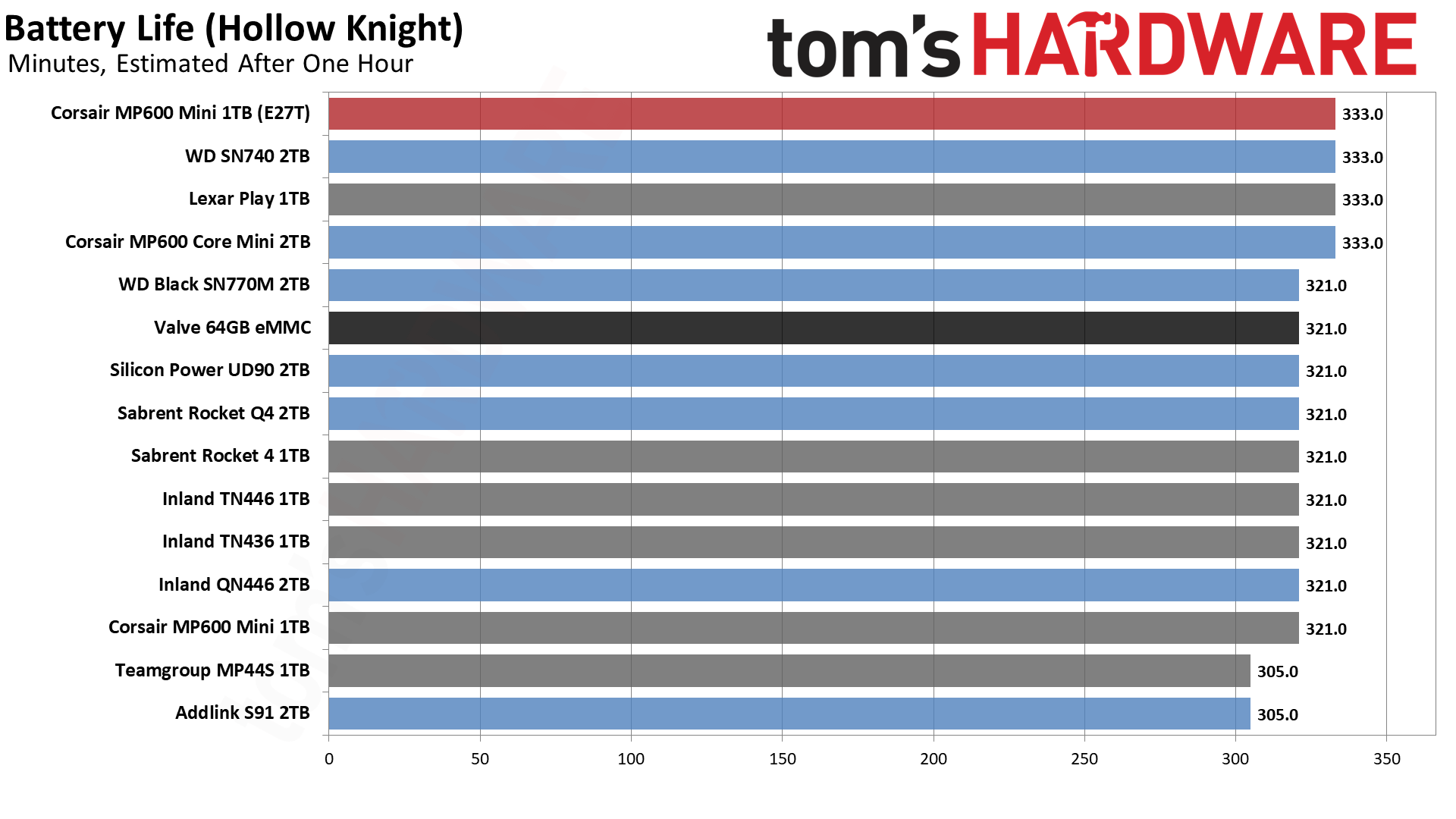
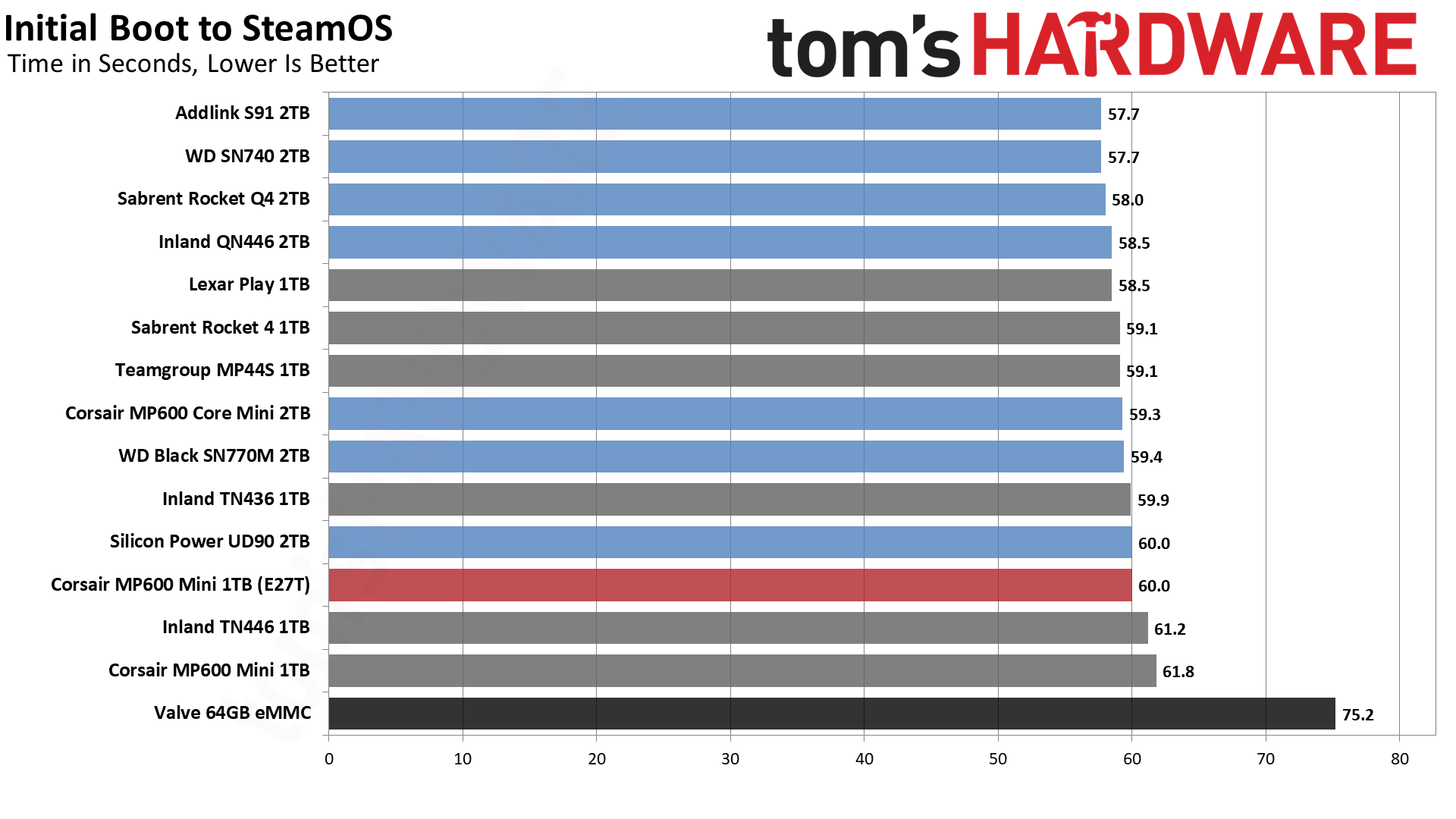
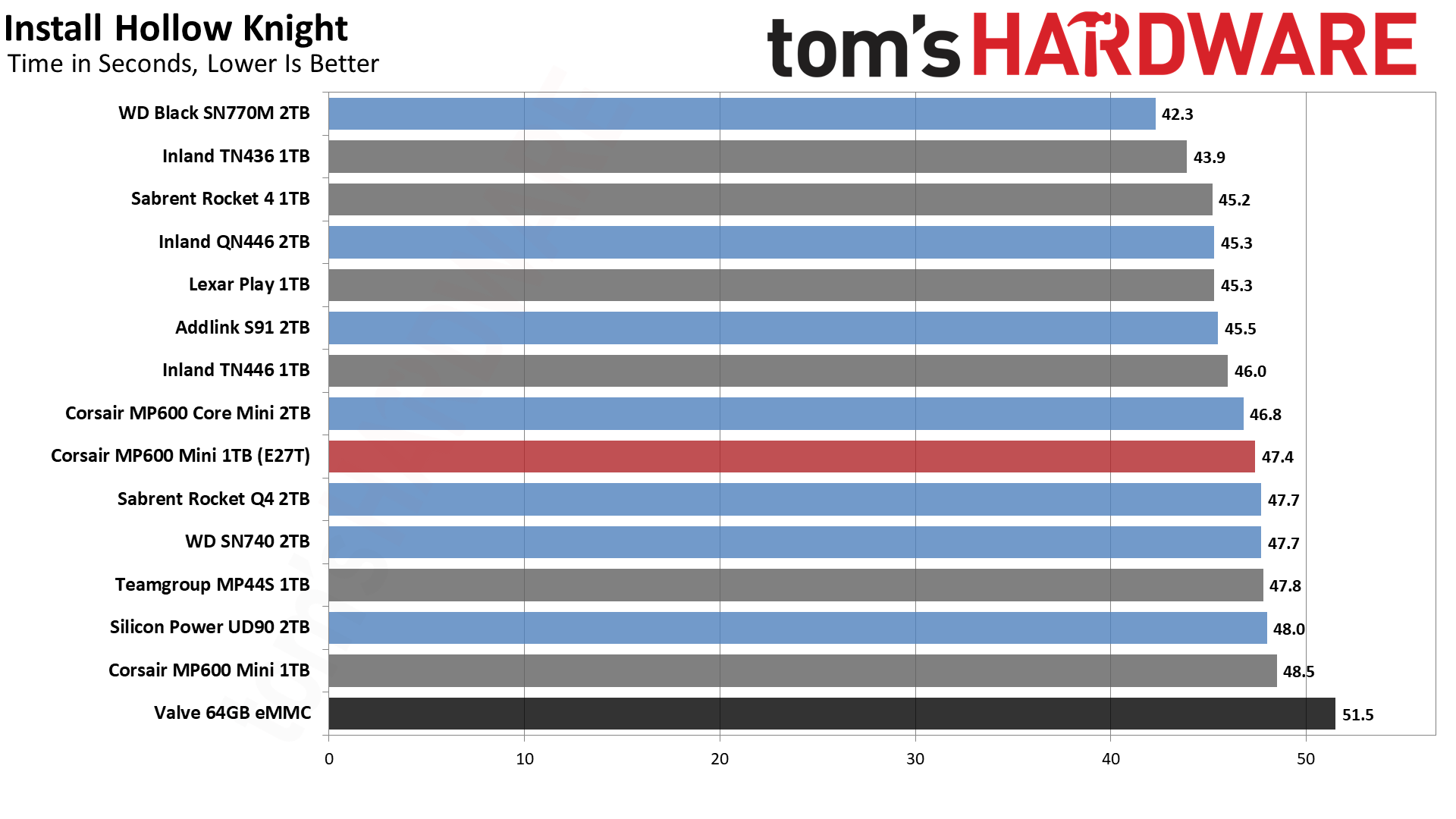
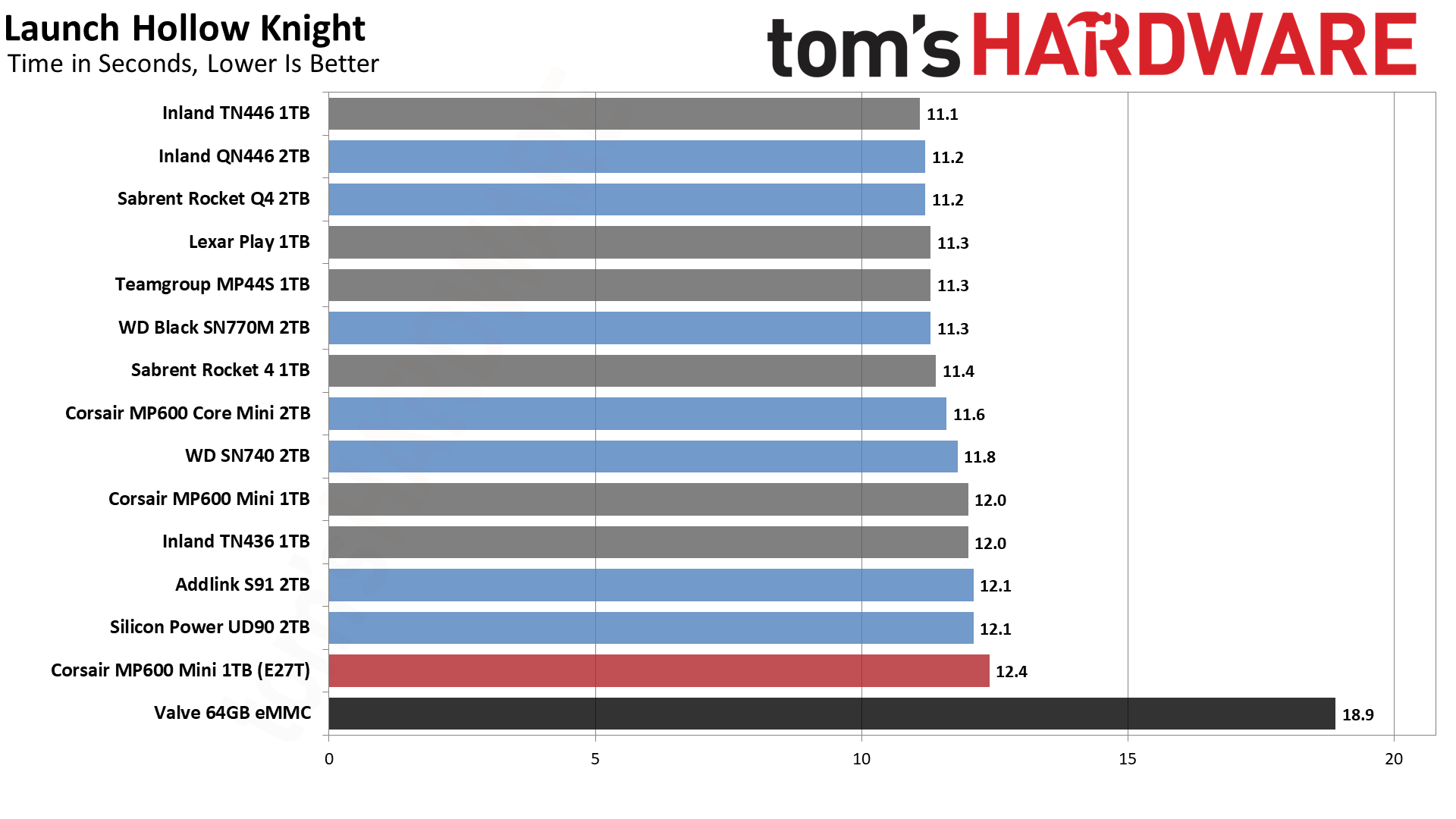

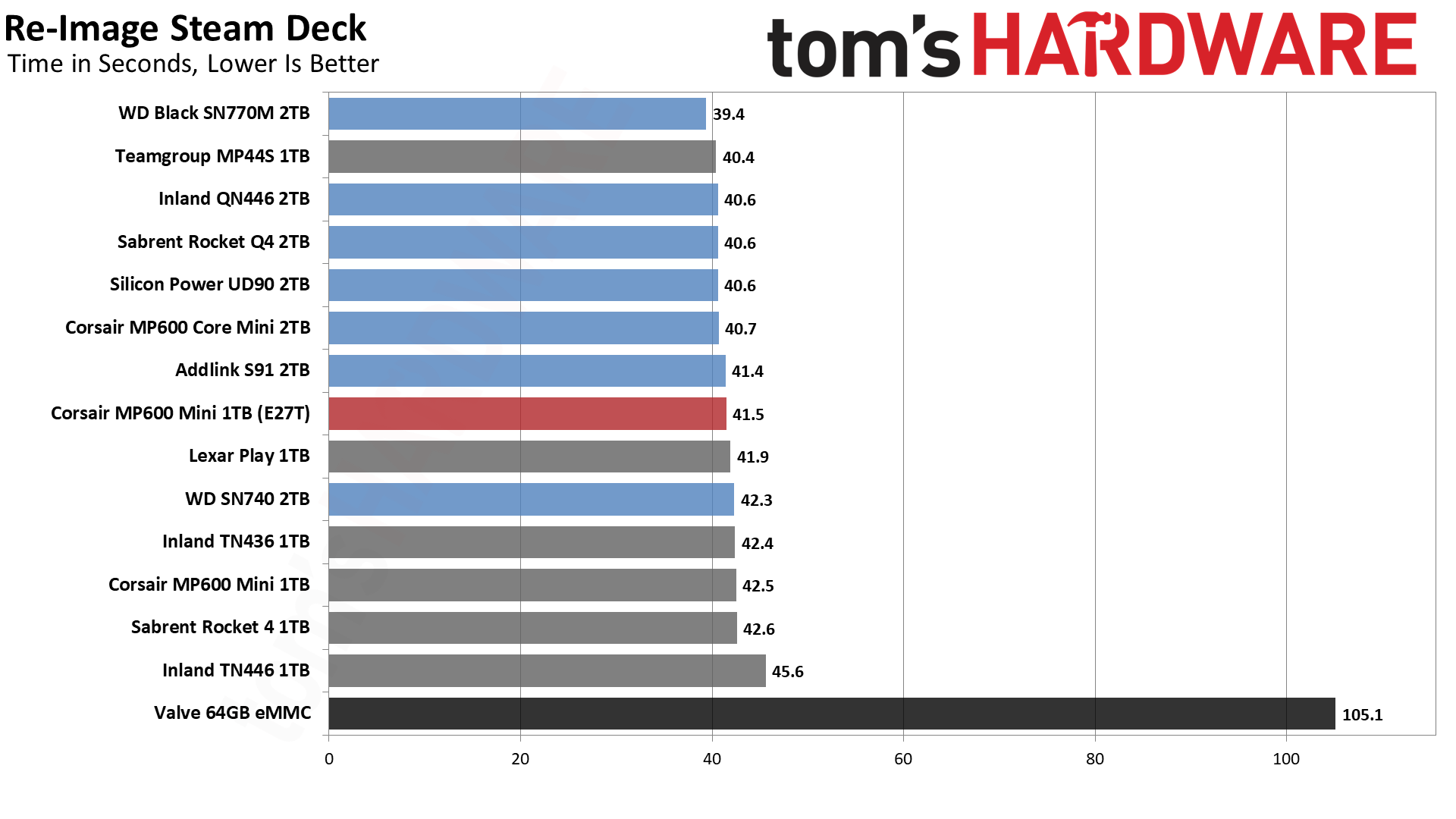
The MP600 Mini’s general Steam Deck testing results are middling on the whole, although the drive does have the fastest SteamOS boot time yet measured. That's likely due to newer SteamOS updates rather than the hardware, however. We think any drive in this list will do for Steam Deck use, and it’s certainly worth upgrading if you have the original 64GB Deck. The MP600 Mini might still be the best choice for when you mostly fill your drive, however — we expect QLC-based SSDs like the MP600 Core Mini, QN447, S91, and MP44S to clearly slow down on writes as they're filled up.
Steam Deck Testing — KDiskMark and Temperature
One of the most popular storage benchmarks is CrystalDiskMark (CDM), which we use in our own Windows-based SSD testing suite. This benchmark relies on Microsoft’s DiskSpd with templated test settings. CDM lets you quickly see how a drive performs against its idealized, rated specifications and the benchmark can also hint at a more “real world” feel with low queue depth I/O testing.
The Linux flavor of this benchmark, which is easy to install on the Steam Deck, is KDiskMark. The “K” refers to the KDE desktop environment used on the Deck. KDiskMark relies on the Flexible I/O tester, or FIO, instead of DiskSpd. For the temperature portion we use data from the SMART sensors on the drive which can be directly polled and from which the maximum temperature can be extracted.
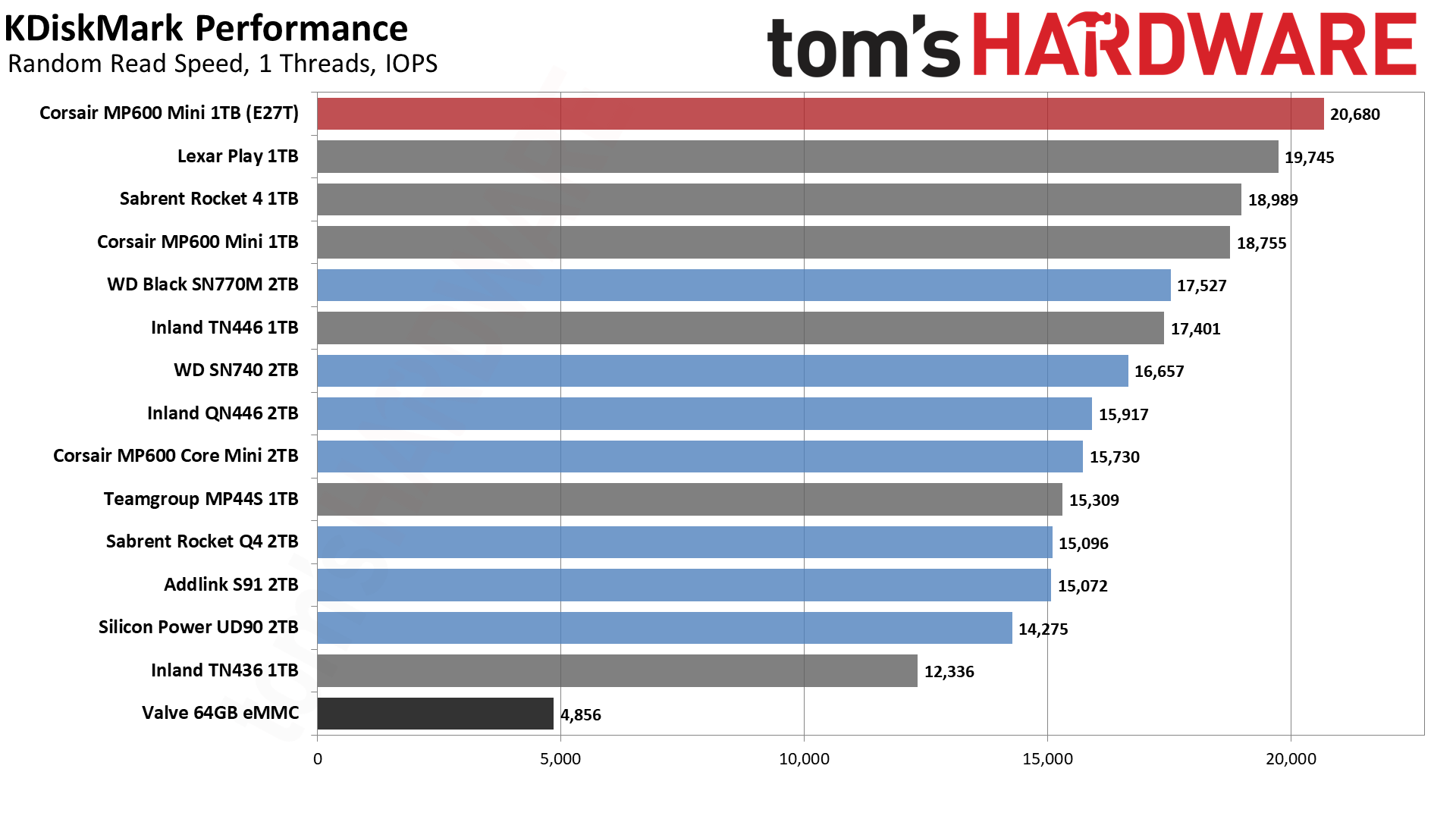

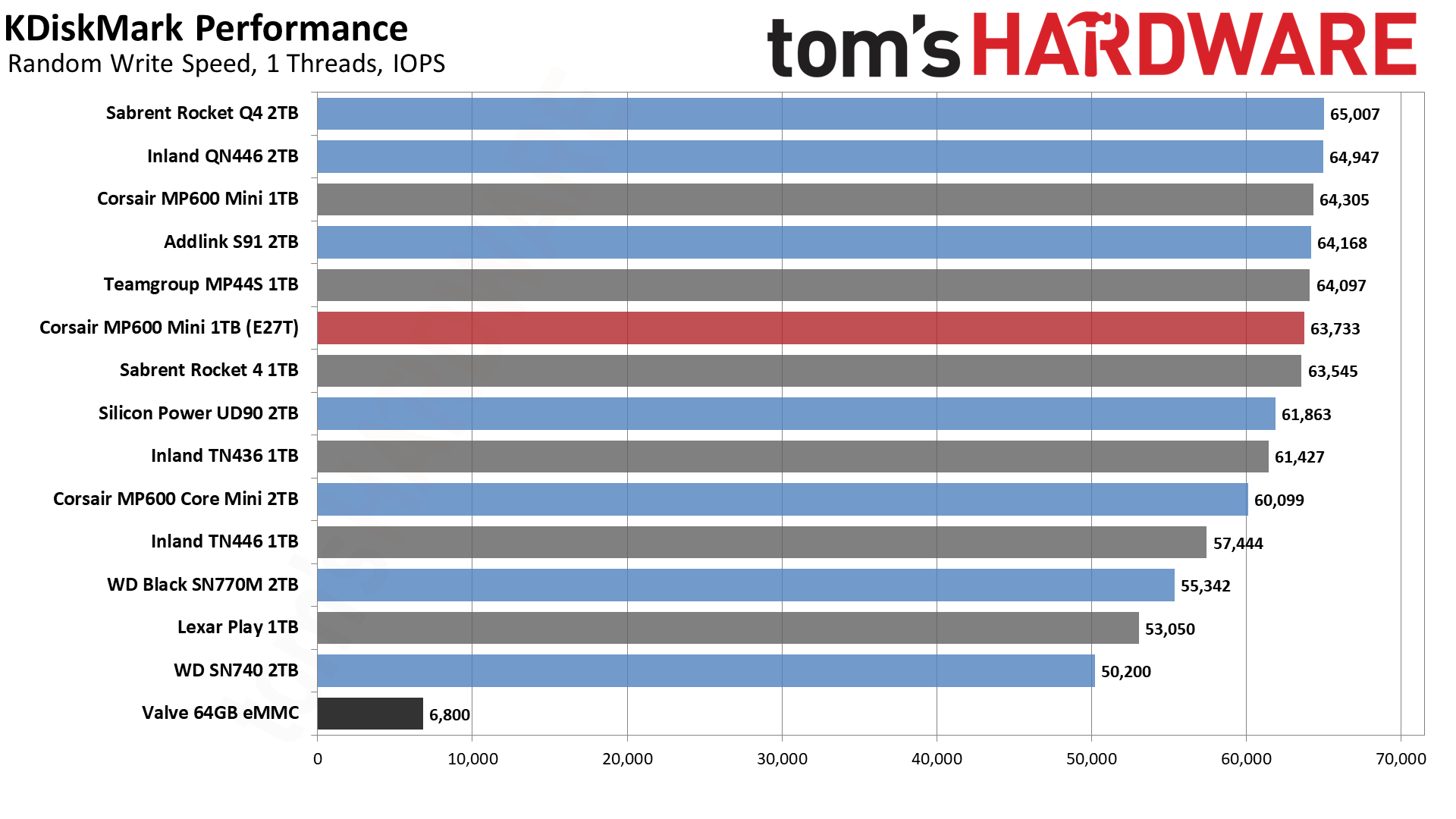

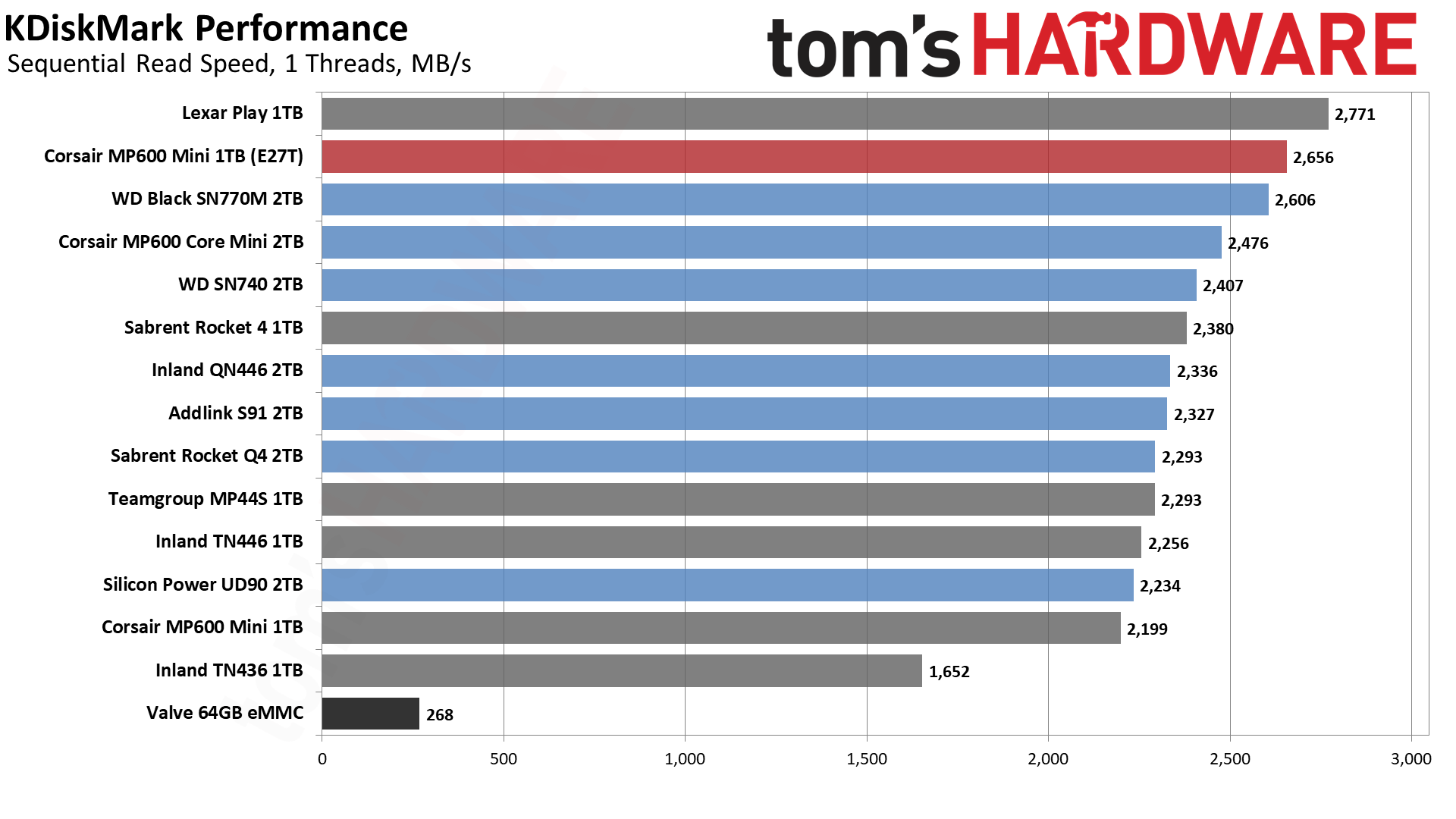
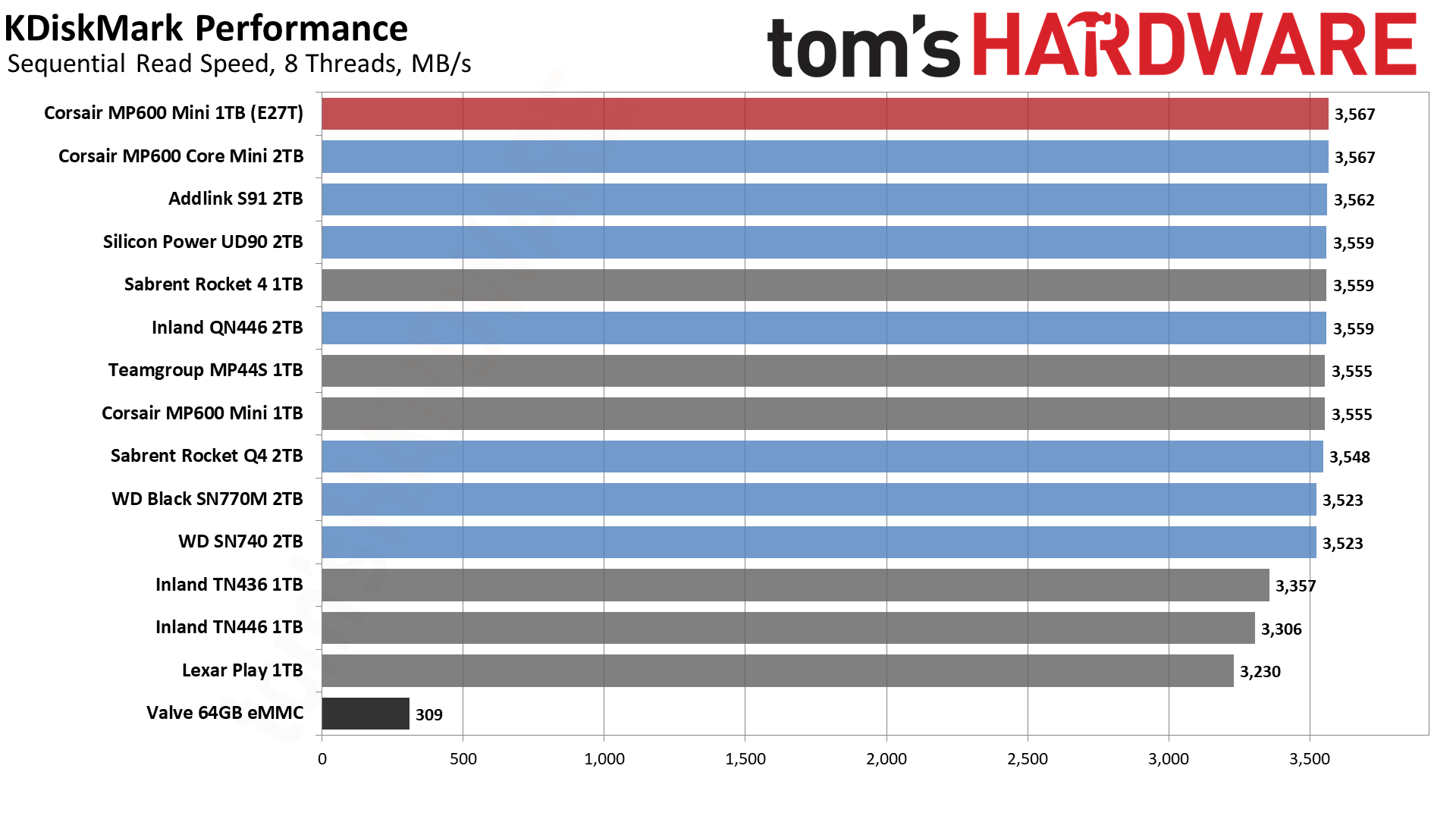
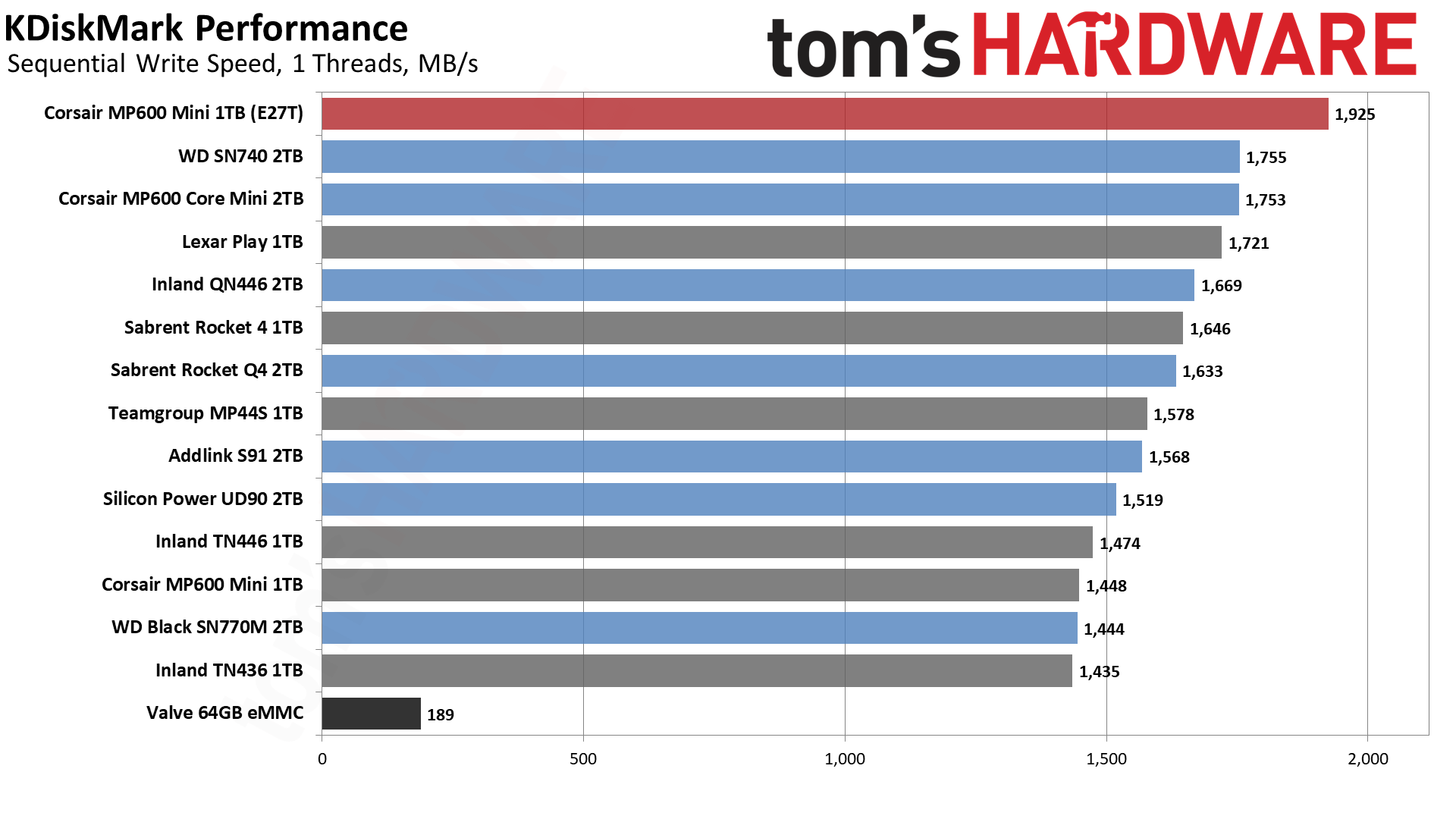
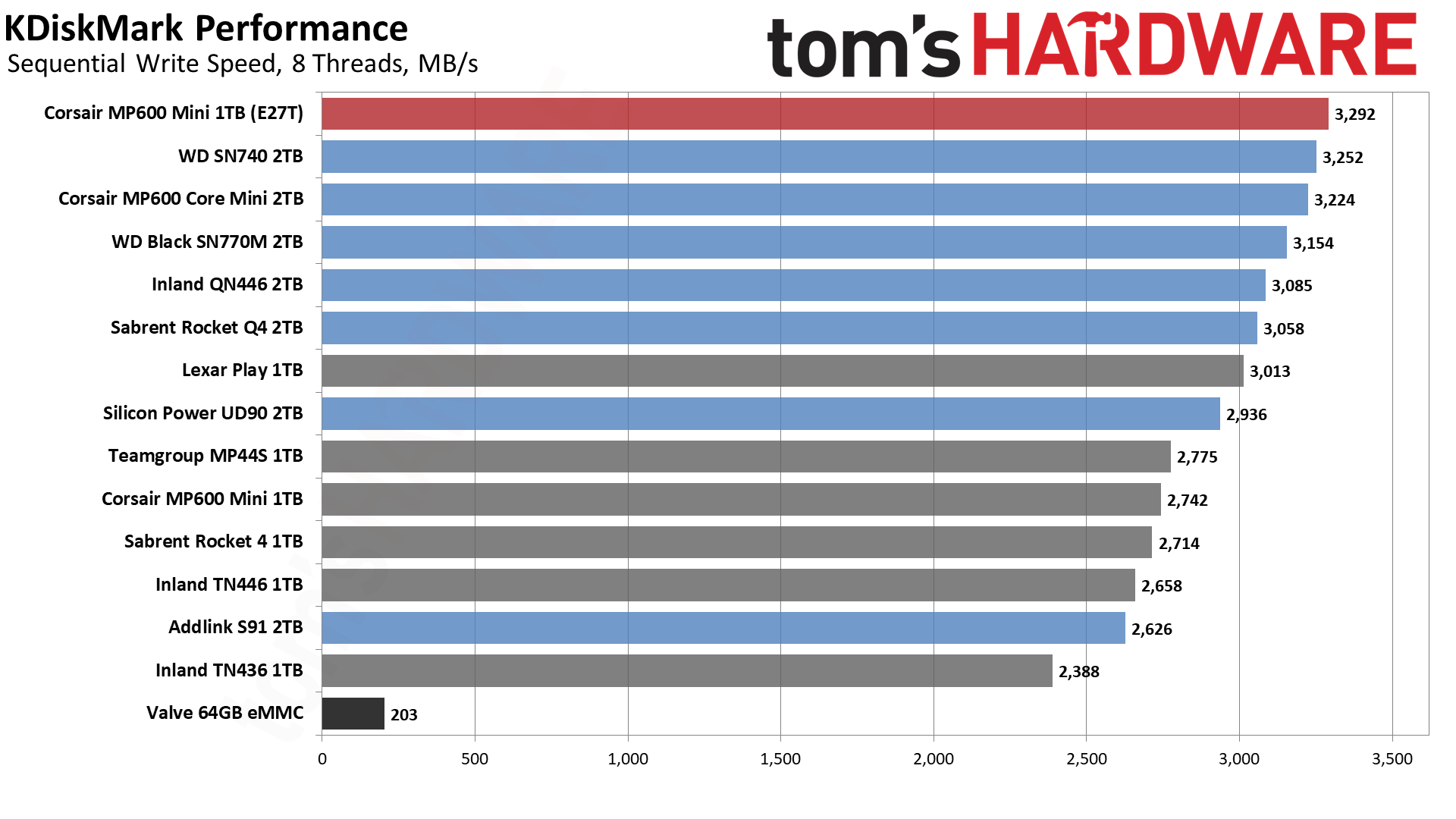
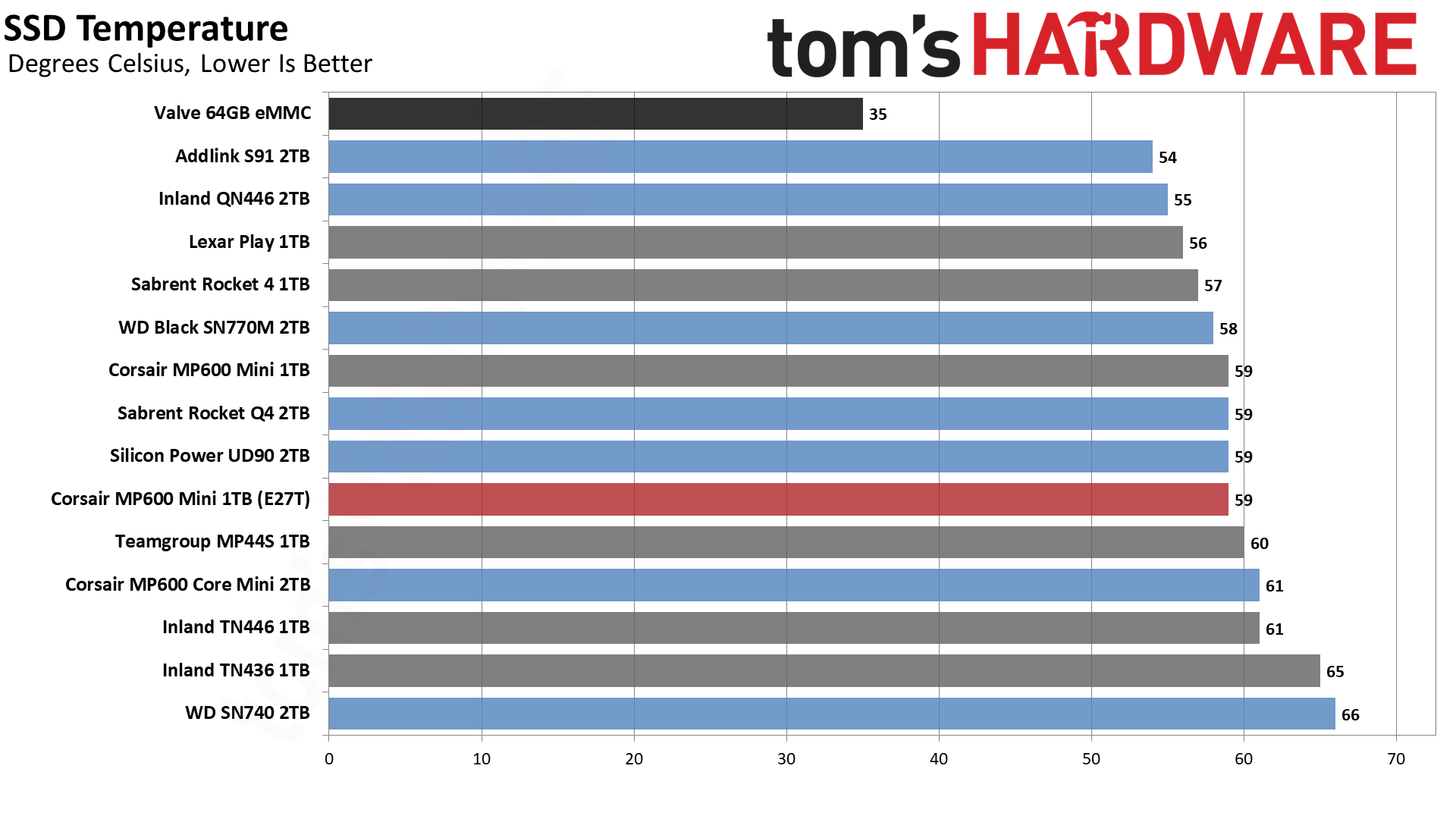
KDiskMark performance remains pretty average, but keep in mind this is on the PCIe 3.0 Steam Deck. The MP600 Mini is still worth a look at 2TB for this device if you want TLC, but its performance opens up at 1TB with a 4.0 host like the ROG Ally. As for temperature, this drive has no issue being comfortable in the Steam Deck. It would likely run a bit hotter in PCIe 4.0 mode, but its small cache likely ensures reliable performance without overheating. If you're looking for consistency, it’s a good choice.
Test Bench and Testing Notes
| CPU | Intel Core i9-12900K |
| Motherboard | Asus ROG Maximus Z790 Hero |
| Memory | 2x16GB G.Skill DDR5-5600 CL28 |
| Graphics | Intel Iris Xe UHD Graphics 770 |
| CPU Cooling | Enermax Aquafusion 240 |
| Case | Cooler Master TD500 Mesh V2 |
| Power Supply | Cooler Master V850 i Gold |
| OS Storage | Sabrent Rocket 4 Plus 2TB |
| Operating System | Windows 11 Pro |
We use an Alder Lake platform with most background applications such as indexing, Windows updates, and anti-virus disabled in the OS to reduce run-to-run variability. Each SSD is prefilled to 50% capacity and tested as a secondary device. Unless noted, we use active cooling for all SSDs.
Corsair MP600 Mini Bottom Line
The Corsair MP600 Mini (E27T) is a natural upgrade to the original MP600 Mini, maintaining good power efficiency with improved performance and a 2TB option. Finally, the entire PCIe 4.0 interface can be utilized. There’s little downside here, except perhaps with pricing and availability. While we've had the MP600 Mini E27T in our labs for over a month now, we simply can't find it for sale anywhere, which also means we don't know what the actual pricing will be.
We also expect the 2TB SKU will lag behind the 1TB in terms of retail availability, and even then it may not be manufactured in larger quantities (depending on demand). There's already high demand for 2TB TLC flash modules, not just for M.2 2230 drives, so we’ll have to wait and see. Other companies will have their own drives based on this hardware later this year and into the next, so it’s a matter of patience either way.
In the meantime, WD’s Black SN770M and SN740 remain good options, although these drives are beginning to feel a little dated. Performance on them is still good, but power efficiency is lackluster and these drives don’t fully push PCIe 4.0. Drives using QLC flash at 2TB, such as with the Sabrent Q4 2230, Corsair MP600 Core Mini, and many more, are viable as well, particularly with PCIe 3.0 host devices like the Steam Deck. However, in some cases, such as with longer file operations and a fuller drive, performance may not be completely consistent.
For 1TB M.2 2230 drives, there are far more options. The Rocket 2230, Inland’s TN446, and the Lexar Play SSD are all pretty solid. These offer good performance without some of the drawbacks of WD’s drives. If you’re looking for M.2 2242, then these drives can be extended, although it seems 2242 versions of the drives are also on the way. As for faster 2242 drives similar to the new MP600 Mini, it’s possible we’ll eventually see those, too, which could make single-sided 2TB and even 4TB a possibility with TLC.
Assuming you can get your hands on the new MP600 Mini, it’s certainly the way to go for high performance 2230 drives. It’s the best overall M.2 2230 drive on the market, at least in terms of performance and efficiency, and effectively comes with no compromises. We just need to know how much it will cost for the 1TB and 2TB models.
We’ll see other drives match or beat it in time, once other manufacturers start shipping E27T with BiCS6 NAND, but it’s pretty close to the edge of what’s possible with PCIe 4.0 technology. We can definitely recommend the new MP600 Mini, though if you're in the market right now and can't wait for retail availability, you can generally settle for existing drives. At or near the same price, though, the MP600 Mini will be the way to go.
MORE: Best SSDs
MORE: How We Test HDDs And SSDs
MORE: All SSD Content

Shane Downing is a Freelance Reviewer for Tom’s Hardware US, covering consumer storage hardware.
